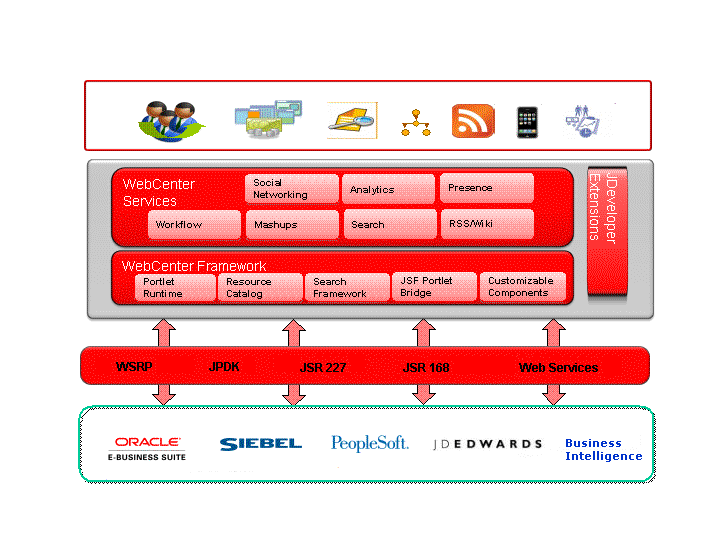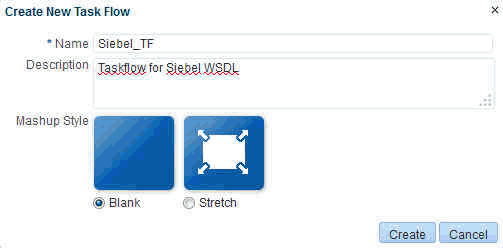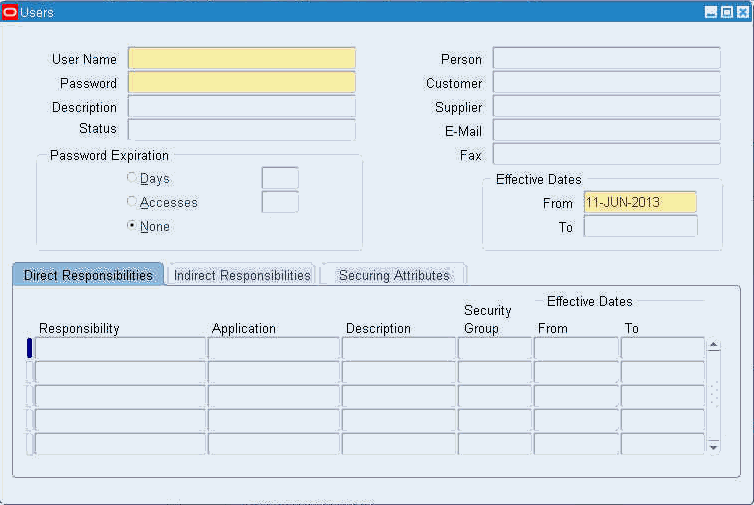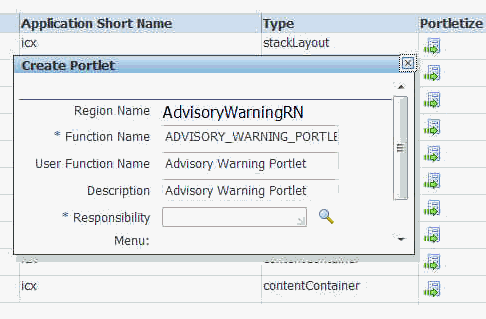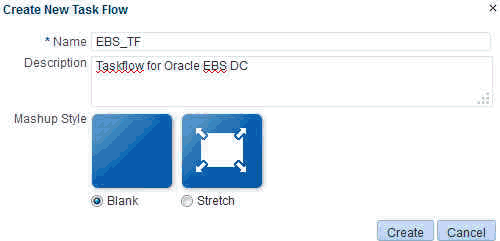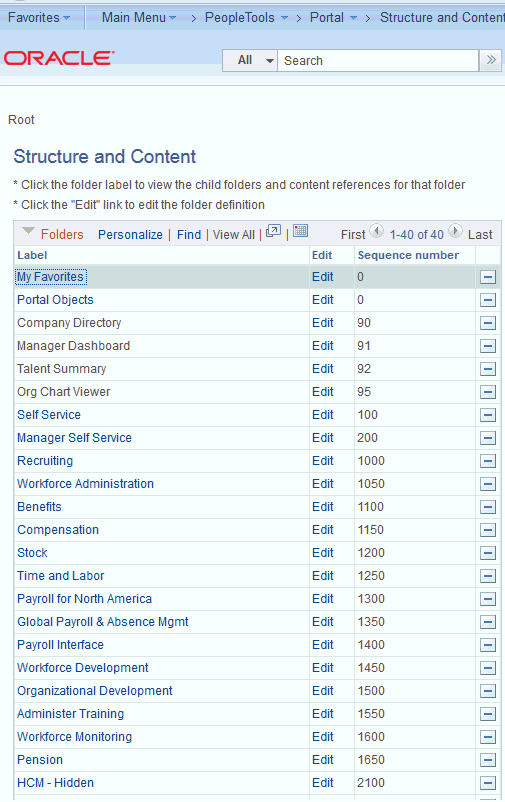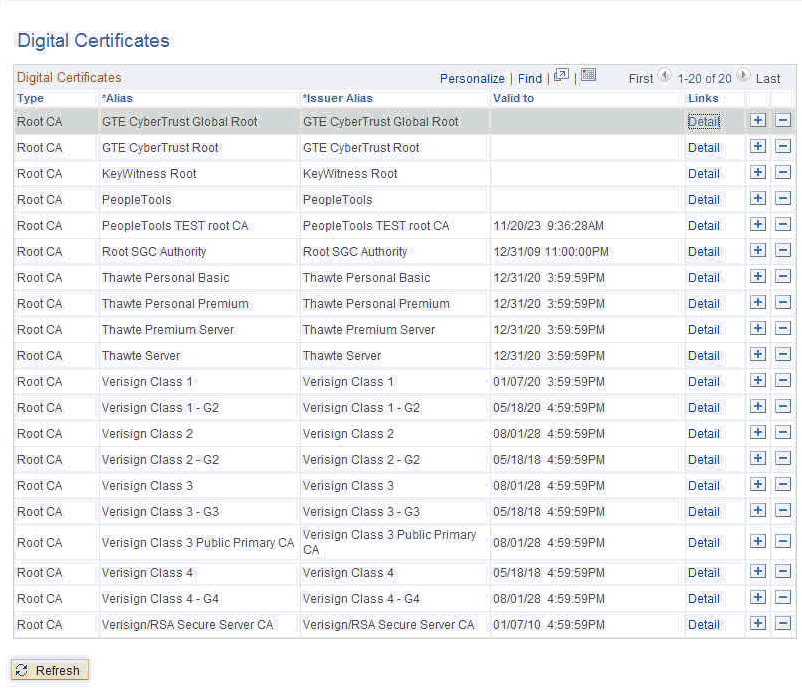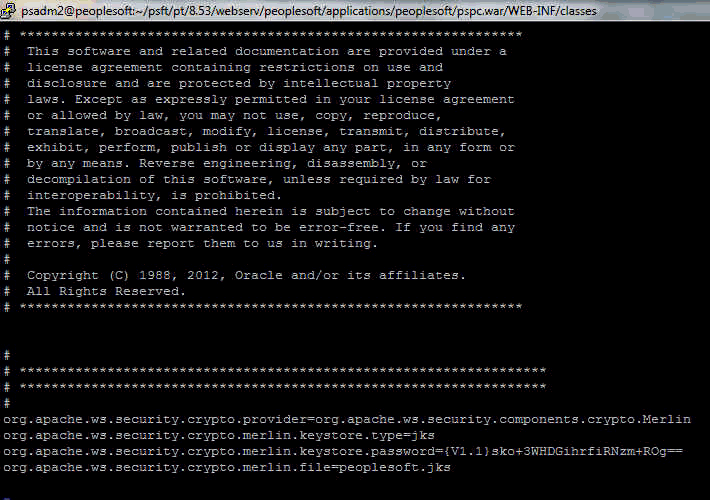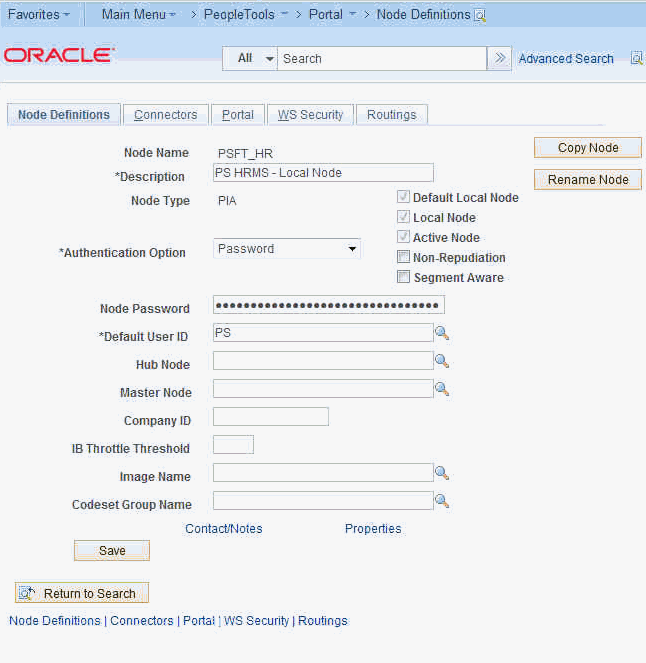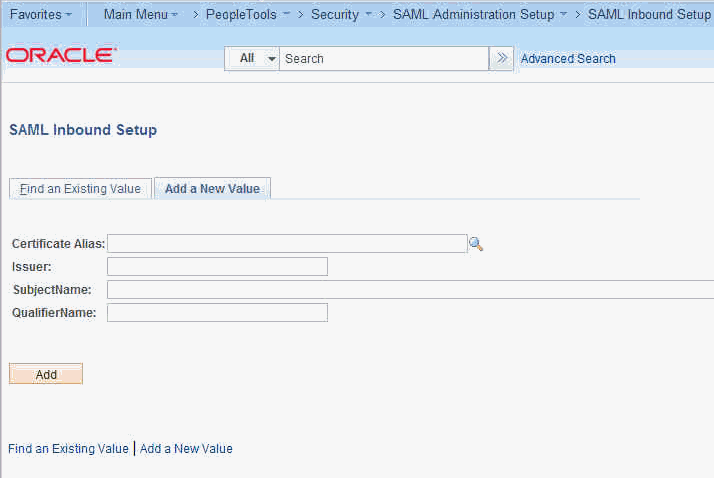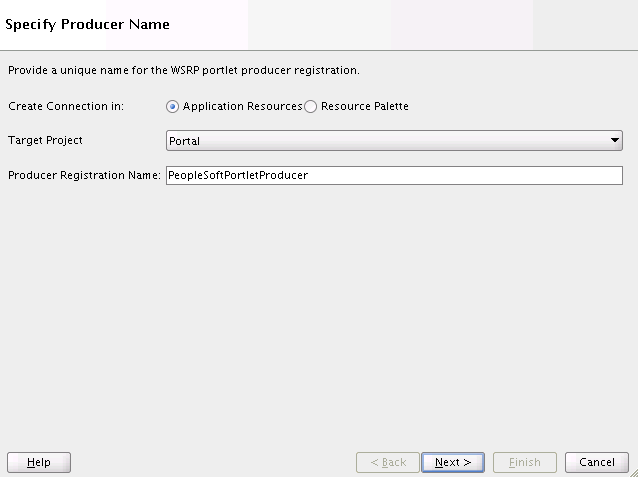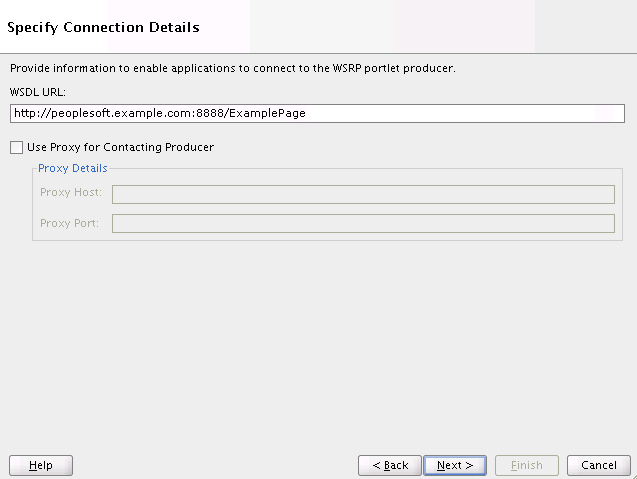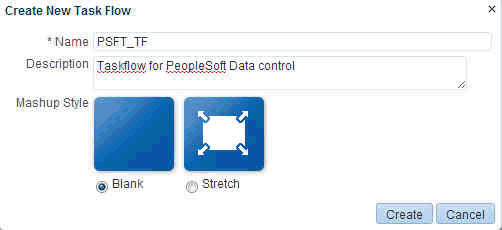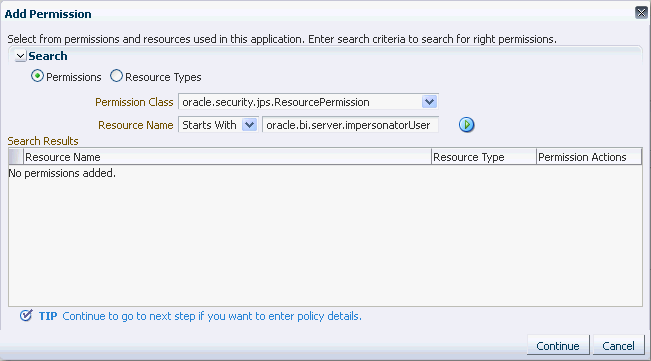54 Integrating Other Oracle Applications
This chapter describes how you can integrate other Oracle applications with your WebCenter Portal or Framework application.
This chapter contains the following topics:
54.1 Integrating Other Oracle Applications in WebCenter Portal
Oracle WebCenter Portal is an integrated suite of technology designed to deliver a unified, context-aware user experience. WebCenter Portal integrates structured and unstructured content, business intelligence, business processes, communication, and collaboration services, and removes the boundaries between enterprise applications. By integrating other applications available within the enterprise with WebCenter Portal, you can create context-centric, composite applications that leverage the capabilities of these applications, extending WebCenter Portal and changing the way people work.
WebCenter Portal uses industry-standard technologies to integrate (primarily as WSRP and JPDK portlets) other application components. Figure 54-1 shows the technologies involved in WebCenter Portal integration with other Oracle applications.
Although not all applications support the same integration mechanisms, the integration process is generally quite simple, consisting of exposing the application object to be integrated as a portlet, registering the portlet with WebCenter Portal, adding the portlet to a page, and then running and testing the results.
In Figure 54-1 we show the applications that can be integrated as Siebel, E-Business Suite, JD Edwards, PeopleSoft, and Oracle Business Intelligence. These Oracle applications are fully supported and documented within this chapter. However, you can integrate virtually any application that can expose objects as WSRP or JPDK portlets. The process for integrating them is the same as for the Oracle applications documented here: expose the object as a portlet, register the portlet in WebCenter Portal, and add the portlet to a page. Refer to the documentation for one of the supported Oracle applications for a description of how to consume an exposed portlet in WebCenter Portal.
54.2 Integrating Siebel Applications
This section describes how to integrate a Siebel Web service in a Portal Framework application. It also describes how to integrate Siebel objects using the Siebel Web Engine (SWE). Siebel and WebCenter can work together to include Siebel's CRM capabilities as portlets within your Portal Framework application. You can integrate Siebel applications as Web services, or using the Siebel Web Engine (SWE) as described in the following subsections:
-
Section 54.2.1, "Integrating Siebel Applications as Web Services"
-
Section 54.2.2, "Integrating Siebel Applications Using the Siebel Web Engine"
54.2.1 Integrating Siebel Applications as Web Services
This section describes how to integrate Siebel applications as Web services in a portal or Portal Framework application.
This section contains the following subsections:
-
Section 54.2.1.2, "Consuming a Siebel Web Service in a Framework Application"
-
Section 54.2.1.3, "Consuming a Siebel Web Service Data Control in a Portal"
54.2.1.1 Preparing the Siebel Application
This section describes how to create an inbound Web service, set up operations for the inbound service, and generate a WSDL that you will later use to create a data control to your portal or Framework application.
This section contains the following subsections:
54.2.1.1.1 Creating an Inbound Web Service
To create an inbound Web service:
-
Log into the Siebel application as an administrator.
-
Navigate to the Administration - Web Services page.
-
Click Inbound Web Services.
The Inbound Web Services page shows the out-of-the-box Web services and any other Web services that are currently exposed.
-
Click Menu and select
New Recordfrom the drop-down list. -
Enter the values for Namespace, Name, Status and Comment as appropriate for the Web service you want to set up. For example:
Field Name Value Namespace http://xmlns.oracle.comName Siebel Customer AccountStatus ActiveComment For Fusion Middleware -
Scroll to the Service Ports pane and select New Record from the Menu drop-down list.
-
Enter
CustAccountas the Name and click Type. -
In the Inbound Web Service Port Type pick applet, open the New tab.
-
Select
Business Serviceas the Implementation Type. -
From the Service Name list, select
Siebel Account. -
In the Inbound Web Service Port Type pick applet, click OK to create the inbound Web service.
-
From the Service Ports dialog's Transport drop-down list, select
HTTP. -
In the Address field, set the URL to your Siebel instance. For example:
http://xmlns.oracle.com/eai_enu/start.swe?SWEExtSource=WebService&SWEExtCmd=Execute&UserName=SADMIN&Password=SADMIN
-
From the Menu drop-down list, select
Save Record.
54.2.1.1.2 Creating Operations for the Inbound Web Service
After creating the inbound Web service (see Section 54.2.1.1.1, "Creating an Inbound Web Service"), continue by adding operations to the inbound Web service and then create a WSDL file, follow these steps:
-
Scroll to the Operations section and select
Newfrom the Menu drop-down list. -
In the Operation Name field, enter
AccountInsert. -
Click Method Display Name to open the Business Service Method dialog.
-
Select
Insertas the Method, and click OK. -
From the Authentication Type drop-down list, select an appropriate authentication type:
Authentication Type Session
TypeDescription None None A single request is sent with an anonymous user login, and the session is closed after the response is sent out. In order for the anonymous session to be identified by the SWSE Plug-in, UsernameToken and PasswordText must be excluded in the SOAP headers.
Username and password None A single request is sent with the username and password used to log in, and the session is closed after the response is sent out. Username and password Stateless The initial request to log in establishes a session that is to remain open and available for subsequent requests. Username/password are used to log in and a session token is returned in a SOAP header included in the outbound response. The session remains open. Session token (stateless) Stateless Request to reconnect to an established session, using the information contained in the session token. If the session has been closed, automatic re-login occurs. The Siebel servers include the session token in the SOAP header of the response. The session remains open. Session token (stateless) None When a SOAP header carries a session token and has the session type set to None, then the Session Manager on the SWSE closes (logs out) of this session, and invalidates the session token. The session token is not used after the session is invalidated. -
Click New to create a new operation.
-
In the Operation Name field, enter a name for the new operation (for example,
AccountQueryByExample). -
Click Method Display Name for the new operation.
-
In the Business Service Method dialog, select the query method (for example, Query By Example) and click OK.
-
Continue by adding any additional operations you may need as described in steps 6 to 9 above.
-
In the Service Ports pane, select
Save Recordfrom the Menu drop-down list. -
In the Inbound Web Services pane, select
Save Recordfrom the Menu drop-down list. -
Select
Clear Cachefrom the Menu drop-down list. -
Click the Generate WSDL.
-
On the File Download dialog, click Open.
-
Select File --> Save As...
-
Locate the directory where you want to save the WSDL file, enter a name for the file and click Save.
54.2.1.2 Consuming a Siebel Web Service in a Framework Application
This section describes how to consume Siebel applications that have been set up as Web services in a Portal Framework application, including how to set up a WSDL-based data control and, how to use JDeveloper's JSF Navigation Modeler to diagrammatically create your application's pages and the navigation between them.
This section contains the following subsections:
-
Section 54.2.1.2.1, "Creating a Data Control Based on a Siebel Web Service"
-
Section 54.2.1.2.3, "Adding Pages and Navigation to the Page Flow Diagram"
54.2.1.2.1 Creating a Data Control Based on a Siebel Web Service
This section describes how to create a WSDL-based data control based on a Web service created from a Siebel application.
To create a WSDL-based data control:
-
Open your Portal Framework application or create a new Portal Framework application in JDeveloper.
-
In the Applications Navigator, right-click the
Modelnode and select New from the context menu. -
In the New Gallery, select
All Technologiesfrom the Filter By drop-down list. -
Select
Business Tier | Web Servicesas the category, select theWeb Service Data Controlitem, and click OK. -
In the Create Web Service Data Control wizard, click Next to leave the Welcome page.
-
In Step 1, enter the Web service name in the Name field.
-
Click Browse for the URL field, locate the directory where you downloaded the WSDL file, select the file and click Open.
In the wizard, note the URL generated in the Service field.
-
Click Next.
Step 2 shows all the operations available from the selected Web service.
-
Using the Add button, shuttle the operations you want to the Selected pane, and then click Next.
When you expand the
Modelnode in the Applications Navigator, you should see nodes for the entries that you have created. -
Click the Save All icon to save your changes.
54.2.1.2.2 Creating a Page Flow Diagram
This section describes how to create the page flow diagram to which you can your add source and query pages.
To create a page flow diagram:
-
In the Applications Navigator, right-click the
ViewControllernode and select New from the context menu. -
In the New Gallery, expand the
Web Tiernode and select JSF. -
In the Items pane, select JSF Page Flow & Configuration (faces-config.xml) and click OK.
-
In the Create JSF Configuration File dialog, click OK to accept default values.
An empty page flow diagram opens with a Component Palette and Data Control Palette to the right of the diagram editor. You use this to create components for the JSF Navigation Model.
-
Click the Save All icon to save your changes.
54.2.1.2.3 Adding Pages and Navigation to the Page Flow Diagram
This section describes how to add pages and navigation to the page flow diagram.
To add pages to the page flow diagram:
-
In the JSF Navigation Diagram Component Palette, create a source page by selecting JSF Page, clicking the diagram and naming the page appropriately (for example,
QueryByID). Typically, you will have at least a source and query page. -
To create the query page, click and drag another JSF Page from the Component Palette and drop it next to the previous one, renaming it appropriately (for example,
ShowResult). -
Select JSF Navigation Case in the JSF Navigation Diagram Component Palette. Click the icon for the source JSF page, and then click the icon for the destination JSF page for the navigation case.
-
Modify the default label (
success) by clicking it and entering an appropriate name (for example,toResult). -
Open the Overview tab and click Navigation Rules.
The rule you just created in the diagram should be listed in the table.
JDeveloper gives you three views of the
faces-config.xmlfile: The same information that is presented in the diagram is also accessible through a declarative dialog and directly from the source. If you open the source view (by clicking the Source tab) the<from-view-id>tag identifies the source page, and the<to-view-id>tag identifies the destination page. -
From the diagram view, select JSF Navigation Case in the Component Palette. Click the icon for the source JSF page, and then click the icon for the destination JSF page for the navigation case.
-
Modify the default label by clicking it and entering an appropriate name (for example,
toQuery). -
Click the Save All icon to save the diagram.
54.2.1.2.4 Creating the Query Page
This section describes how to create and set up navigation for the query page.
To create the query page:
-
On the Page Flow diagram, double-click the source page icon (
QueryById) to launch the Create JSF JSP Wizard. -
Click Next to leave the Welcome page.
-
In Step 1 of the wizard, select JSP Document (*.jspx) and click Next.
-
In Step 2, make sure Do Not Automatically Expose UI Components in a Managed Bean is selected and click Next.
-
In Step 3, make sure the following libraries are selected:
ADF Faces Components 10_1_3_2_0 ADF Faces HTML 10_1_3_2_0 JSF Core 1.0 Cusomizable Components Core 10_1_3_2_0
-
Click Finish to create the page.
An empty JSF page opens in the Design tab of the editor.
-
In the Customizable Components Core component palette, click ShowDetailFrame.
The ShowDetailFrame appears in the page.
Note:
WebCenter Portal provides two customizable components:PanelCustomizableandShowDetailFrame. These two components make it very easy to organize the content of your Web application, treating different panels as if they are almost stand-alone, portlet-like objects that can be minimized, rearranged, have their own drop-down menus, and so on. -
With the ShowDetailFrame selected, modify the Text property in the Properties Inspector to Query By ID. Press [Enter] to update the page in the Visual Editor.
-
Open the Data Control palette and expand the Siebel Web services node. Drag and drop the
AccountQueryById(String)node onto the ShowDetailFrame on the page. -
In the popup menu, select Create | Parameters | ADF Parameter Form.
-
In the Edit Form Fields, click OK.
-
Select the AccountQueryById button generated in the page and in the Property Inspector pane, change the following properties:
Text Submit Action toResult
-
Select the input field corresponding to the input value, and in the Property Inspector, change the Label property to
Account ID: -
Click the Save All icon to save your work.
54.2.1.2.5 Creating the Results Page
This section describes how to create and add navigation for the results page.
To create the results page:
-
Click the faces-config.xml tab to return to the Page Flow diagram and double-click the ShowResult icon to launch the page wizard.
-
Click Next to skip the Welcome page.
-
In Step 1 of the wizard, select JSP Document (*.jspx) and click Next.
-
In Step 2, make sure Do Not Automatically Expose UI Components in a Managed Bean is selected and click Next.
-
In Step 3, make sure the following libraries are selected:
ADF Faces Components 10_1_3_2_0 ADF Faces HTML 10_1_3_2_0 JSF Core 1.0
-
Click Finish to create the page.
An empty JSF page opens in the Design tab of the editor.
-
In the Customizable Components Core component palette, click ShowDetailFrame.
The ShowDetailFrame appears in the page.
-
With the ShowDetailFrame selected, modify the Text property in the Properties Inspector to Query Results. Press [Enter] to update the page in the Visual Editor.
-
In the Data Control palette, expand AccountQueryById | Return | SiebelMessage | ListofAccountInterface, select the Account node and drop it on the page on the ShowDetailFrame.
-
In the popup menu, select Create | Forms | ADF Read-only Form.
-
In the Edit Form Fields, delete all fields except for the following:
AccountID AccountStatus NumberOfEmployees CurrencyCode Location MainPhoneNumber Name Type
-
Check the Include Submit Button checkbox and click OK.
-
In the Action Binding Editor, click OK.
-
Click Submit and in the Property Inspector change the title to
Back to Query, and in the Action field selecttoQueryfrom the list. -
Click the Save All icon to save your work.
54.2.1.2.6 Testing the Application
This section describes how to test the application's JSF pages in JDeveloper. Before you can query a Siebel Account using an ID, you need to determine the IDs that are available in your Siebel instance. To perform the following steps you must have access to Siebel Call Center.
To determine the IDS and test your JSF pages:
-
Log into Siebel Call Center, providing the appropriate user ID and password.
-
Navigate to the Accounts List using Site Map.
-
Click Accounts, then Accounts List.
-
From the returned list, highlight the account you want to query.
-
From the Help menu, select About Record.
-
Find the ID value in the Row # field and make a note of it.
-
Return to the page flow diagram and right-click the QueryById page icon and select Run from the context menu.
The page is loaded in your default browser.
-
In the ID field, enter the value you previously noted in the the Row # field and click Submit.
The Details page displays the detail information for the corresponding account.
54.2.1.3 Consuming a Siebel Web Service Data Control in a Portal
This section describes how you can create a Web Service data control and add it to a portal page. The steps in this section assume that you have prepared the application and generated a WSDL as described in Section 54.2.1.1, "Preparing the Siebel Application."
Note:
Before you can add a data control or task flow containing a data control to a portal page you must first have configured WS-Security for WebCenter Portal. For more information about configuring WS-Security, see the "Configuring WS-Security" chapter in Oracle Fusion Middleware Administering Oracle WebCenter Portal.For more information about creating a Web service data control, see the "Creating a Web Service Data Control" section in Oracle Fusion Middleware Building Portals with Oracle WebCenter Portal. For information about Web service data controls, see also the "Web Service Data Controls" section in Oracle Fusion Middleware Building Portals with Oracle WebCenter Portal.
To create a Web service data control:
-
In WebCenter Portal or the portal in which you want to create the data control, go to either the Shared Assets or Assets page.
-
Select Data Controls and click Create.
The Create New Data Control dialog displays (see Figure 54-33).
Figure 54-2 Create New Data Control Dialog

Description of "Figure 54-2 Create New Data Control Dialog"
-
In the Create New Data Control dialog, enter a Name and Description for the data control, select
Web Serviceas the Data Control Type, and then click Continue. -
Enter the WSDL URL that you generated in Section 54.3.4.1, "Generating the WSDL" and other details for the data control and click Continue.
-
Click Show Methods.
-
Select the method(s) to make available and click Next.
-
Enter the parameter default values, if any, and click Create.
-
To make the data control available, from the Shared Assets or Assets page, select Task Flows. The Create New Task Flow dialog displays (see Figure 54-35).
-
Enter the task flow Name and Description, select the Mashup Style to use click Create to create the task flow.
-
Select the task flow and click the Edit icon.
-
Add the data control (with param form) as a table onto the task flow and verify the data.
-
To make the task flow available, navigate to Administration > Business Role Pages.
-
Select Business Role Page and click the Create icon.
-
Edit the page and save the changes.
-
Drop the task flow onto the page and verify the data.
54.2.2 Integrating Siebel Applications Using the Siebel Web Engine
As well as integrating Siebel applications using Web services, you can also integrate Siebel applications in a Portal Framework application using the Siebel Web Engine (SWE).
Siebel Web Engine (SWE) is responsible for rendering the Siebel User Interface. Siebel Web Templates provide this HTML layout information (markup information) to the Siebel Web Engine when rendering Siebel objects in the repository definition of the application. The markup that SWE returns can also be XML for rendering within XML-aware applications or WML (wireless markup language) for rendering on wireless devices. This lets you request the SWE to return a Siebel View as XML, parse the data elements, and display the result in a Portal Framework application.
For instructions on how to use SWE within a Portal Framework application, follow the tutorial >Using the Siebel Web Engine (SWE) to View Data in a WebCenter Application.
To complete the tutorial, you will need the following:
-
Have access to or have installed Oracle JDeveloper Studio Edition
-
Have access to or have installed Oracle's Siebel eBusiness Applications.
-
Have access to a supported version of Windows Internet Explorer (IE) (see the System Requirements and Supported Platforms Guide for Siebel that is available on OTN).
Also refer to the Siebel Bookshelf Guides: >Siebel Portal Framework Guide (specifically, the section on delivering content to external Web applications), and >Configuring Siebel Business Applications Guide for details on SWE and Web Templates.
54.3 Integrating E-Business Suite Applications
This section describes how to integrate E-Business Suite applications in WebCenter Portal applications.
This section contains the following subsections:
-
Section 54.3.1, "Introduction to Integrating EBS Applications"
-
Section 54.3.2, "Required Configurations for Integrating EBS"
-
Section 54.3.3, "Integrating EBS Applications as WSRP Portlets"
-
Section 54.3.4, "Integrating EBS Applications as Data Controls in WebCenter Portal"
54.3.1 Introduction to Integrating EBS Applications
This section describes the integration points and requirements integrating Oracle E-Business Suite portlets in portals and Framework applications.
This section includes the following subsections:
54.3.1.1 Understanding EBS Integration
Out-of-the-box, Oracle E-Business Suite OA Framework-based portlets, such as Applications Navigator, Favorites, and Worklist are WSRP and JSR 168-compliant. That means that you can access these Oracle E-Business Suite portlets from WSRP-compliant portal servers such as portals or Framework applications, by simply adding the portlet onto an application page. Follow the instructions in Section 54.3.3.2.3, "Creating a JSF Page to Consume the Remote Producer" to add them to a Framework application page, or Section 54.3.3.3.3, "Adding the EBS Portlet to a Portal Page" to add them to a portal page.
You can also create new E-Business Suite portlets that are WSRP and JSR 168-compliant that can similarly be added to a Portal Framework application. Creating and consuming WSRP and JSR 168 compliant portals in WebCenter Portal is described in Section 54.3.3.2, "Integrating EBS Applications in a Framework Application" and Section 54.3.3.3, "Integrating EBS Applications in a Portal."
54.3.1.2 Requirements for Integrating EBS Applications
The following requirements apply for integrating Oracle E-Business Suite portals into Oracle WebCenter Portal applications:
-
Regions to be exposed as portlets must be created using Oracle E-Business Suite OA Framework Release 12 as previous versions are not WSRP/JSR 168-compliant.
-
Oracle E-Business Suite can be configured to use Oracle Internet Directory (OID) and one of following single sign-on solutions:
Caution:
Both WebCenter and Oracle E-Business Suite must share the same OID instance and user IDs.-
Oracle Single Sign-On (OSSO)
-
Oracle Access Manager (OAM)
If you are using OSSO, follow the steps in My Oracle Support document 376811.1 to integrate E-Business Suite Release 12 with OID and OSSO.
If you are using OAM, follow the steps in My Oracle Support document 975182.1 to integrate E-Business Suite Release 12 with OAM.
E-Business Suite can also be configured to OID without OAM or OSSO. For more information, see Section 54.3.2.1, "Preparing OID for Use Without Single Sign-On."
Note:
Although Oracle E-Business Suite can be configured to use Oracle Internet Directory (OID) without single sign-on, this is not a recommended approach as users will be prompted for credentials each time they move to or from the integrated portal or data control. -
-
You must have granted the portal or Framework application access to the E-Business Suite Portlet Producer and added and configured the appropriate users.
Note:
To complete some steps, you may need system administrator permissions.54.3.2 Required Configurations for Integrating EBS
This section contains configurations that should be undertaken prior to attempting to integrate portal or data controls into your portal or Framework application.
This section contains the following subsections:
-
Section 54.3.2.1, "Preparing OID for Use Without Single Sign-On"
-
Section 54.3.2.3, "Configuring the EBS Applications Profile Options"
-
Section 54.3.2.4, "Adding the WebCenter Host as a Trusted Portal Using AutoConfig"
-
Section 54.3.2.4, "Adding the WebCenter Host as a Trusted Portal Using AutoConfig"
54.3.2.1 Preparing OID for Use Without Single Sign-On
This section describes the steps to configure OID as an optional standalone environment without using either OAM or OSSO. Note that this is not a recommended approach as users will be prompted for credentials each time they move to or from an integrated portal or data control. If you have installed an SSO solution, continue with Section 54.3.2.2, "Creating a User in EBS and Assigning a Responsibility."
Caution:
Both WebCenter and Oracle E-Business Suite must share the same OID instance and the same user IDs.-
Register the OID instance on the host server by following the steps below:
-
Run the following command:
$FND_TOP/bin/txkrun.pl -script=SetSSOReg -registerinstance=yes -
Supply the required information at the following prompts:
Enter the host name where the Oracle iAS Infrastructure database is installed ? <Enter the OID Host> Enter the LDAP Port of the Oracle Internet Directory server ? <Enter the LDAP Port> Enter SSL LDAP Port of the Oracle Internet Directory server ? <Enter the LDAP SSL Port> Enter the Oracle Internet Directory Administrator (orcladmin) Bind password ? <Password> Enter Oracle E-Business apps database user password ? <Password>
-
Restart all the services by navigating to
$ADMIN_SCRIPTS_HOMEand running:./adstpall.sh apps/<apps to stop>and then:
./adstrtal.sh apps/<apps to start>
-
-
Register OID by following the steps below:
-
Run the following command:
$FND_TOP/bin/txkrun.pl -script=SetSSOReg -registeroid=yes -
Supply the required information at the following prompts:
Enter LDAP Host name ? <Enter the OID Host> Enter the LDAP Port on Oracle Internet Directory server ? <Enter the LDAP Port> Enter the Oracle Internet Directory Administrator (orcladmin) Bind password ? <Password> Enter the instance password that you would like to register this application instance with ? <Password> Enter Oracle E-Business apps database user password ? <Password>
-
Restart all the services by navigating to
$ADMIN_SCRIPTS_HOMEand running:./adstpall.sh apps/<apps to stop>and then:
./adstrtal.sh apps/<apps to start>
-
-
Continue by configuring EBS profile options as shown in Section 54.3.2.3, "Configuring the EBS Applications Profile Options."
54.3.2.2 Creating a User in EBS and Assigning a Responsibility
For integration with EBS to work, WebCenter and EBS must have a common OID identity store. With a common OID, you can either create a new user in EBS, or use an existing user in OID, and then assign a responsibility to that user. This will ensure that the user has access to the portlets in WebCenter. Else the register producer will not have any portlets if we do not assign a responsibility.
To create a new user and assign a responsibility:
-
Log into EBS as a system administrator if not already logged in.
-
In the Navigation pane, expand the System Administrator node, expand Security, expand User, and then click Define.
The Users window displays (Figure 54-4).
-
Enter the User Name, and Password. The Password Expiration options should be set to None.
-
Open the Direct Responsibilities tab, and search for the Responsibility to add and assign the Application to associate with it (for example, search for
Preferences SSWAand assignOracle iProcurementto it), and then click Save (see Figure 54-5).Figure 54-5 Users Window Showing the Direct Responsibilities Tab
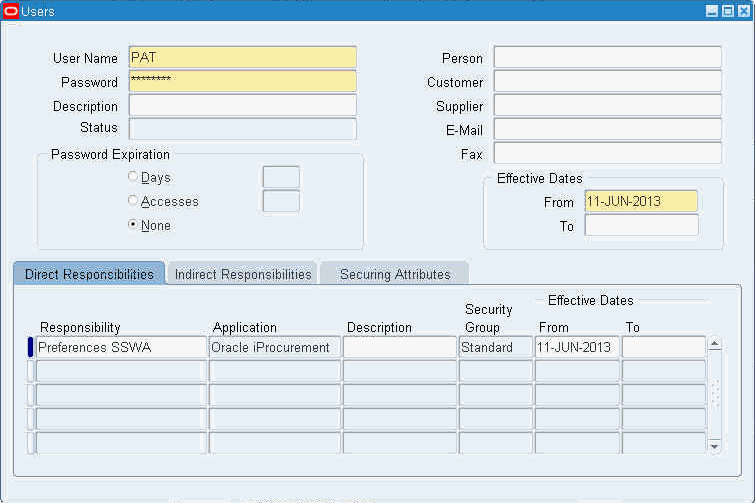
Description of "Figure 54-5 Users Window Showing the Direct Responsibilities Tab"
-
To confirm, log in with the newly created user and check that the application associated with the Responsibility is listed.
-
Continue by configuring the EBS Application Profile Options as described in Section 54.3.2.3, "Configuring the EBS Applications Profile Options."
54.3.2.3 Configuring the EBS Applications Profile Options
This section describes how to configure EBS Applications Profile Options and is a requirement for both SSO and non-SSO configurations.
To configure the EBS profile options:
-
Log into EBS as a system administrator.
-
In the Navigation pane, expand the System Administrator node, and then click Define Profile Options.
-
Close the Profiles window.
-
In the Navigator, select Profile System Values and click Open.
The Find System Profile Values window displays (see Figure 54-6)
Figure 54-6 Find System Profile Values Window
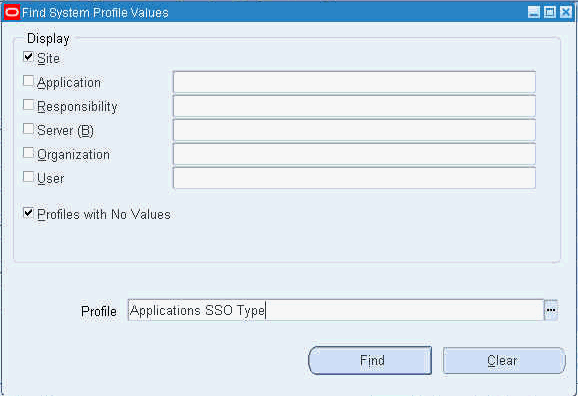
Description of "Figure 54-6 Find System Profile Values Window"
-
Enter the Profile name to update and click Find.
The System Profile Values window displays (see Figure 54-7).
Update the values for the following profiles, saving your entries after each update:
Applications SSO Enable OID Identity Add Event =EnabledApplications SSO Login Types =
BothApplication SSO LDAP Synchronization = Enabled
Applications SSO Type =
SSWA w/ SSOLink Applications user with OID user with same username = Enabled
-
Restart all the services by navigating to
$ADMIN_SCRIPTS_HOMEand running:./adstpall.sh apps/<apps to stop>and then:
./adstrtal.sh apps/<apps to start> -
Continue by adding the WebCenter host as a trusted host as described in Section 54.3.2.4, "Adding the WebCenter Host as a Trusted Portal Using AutoConfig."
54.3.2.4 Adding the WebCenter Host as a Trusted Portal Using AutoConfig
The EBS WSDL is protected and before you can access it you must first add an entry for the consuming WebCenter instance's host using the EBS AutoConfig tool. Note that without this configuration step you will get a "403 Forbidden" error if you try to access the WSDL.
To add the WebCenter host as a trusted portal:
-
Log into EBS as a system administrator if you are not already logged in.
-
In the Navigation pane, expand the System Administrator node, expand Oracle Applications Manager, and then click Workflow.
-
Open the Sitemap tab and click AutoConfig.
-
In the Edit Parameter column, click the Edit icon in the Applications Tier row.
-
Open the System tab and expand the
oa_web_servernode. -
In the list of nodes, look for any that have access to Portlet Producer URLs, add the WebCenter Host and click Save. If you need to add multiple host name, add them separated by space.
-
Run the autoconfig script entering
appsas the password when prompted:cd $ADMIN_SCRIPTS_HOME./adautocfg.sh -
Restart all the services by running the following commands from
$ADMIN_SCRIPTS_HOME:./adstpall.sh apps/<apps to stop>and then:
./adstrtal.sh apps/<apps to start>
54.3.3 Integrating EBS Applications as WSRP Portlets
This section describes how to integrate EBS regions as WSRP portlets in a portal or Framework application. To start, you'll need to generate the portlet for the region using the Portlet Generator, and then continue by registering the producer and integrating it in your application.
This section contains the following subsections:
-
Section 54.3.3.1, "Preparing the EBS Portlet for Remote Access"
-
Section 54.3.3.2, "Integrating EBS Applications in a Framework Application"
-
Section 54.3.3.3, "Integrating EBS Applications in a Portal"
54.3.3.1 Preparing the EBS Portlet for Remote Access
Oracle E-Business Suite provides a tool called Portlet Generator to convert existing standalone Oracle Application Framework regions into portlets. To be available for portletization, a region must have the following properties.
-
Regions must have an Application Module (AM) defined and must have its standalone property set to
true. -
Inline regions must have an AM defined and have its standalone property set to
true. -
Content regions must have an AM defined (content regions do not have a standalone property)
To expose EBS functionality as a portlet using Portlet Generator:
-
Log into EBS as a system administrator.
-
In the Navigation pane, expand the Functional Administrator node, and then click Home.
The Application Administration page displays (see Figure 54-8).
Figure 54-8 Application Administration Page
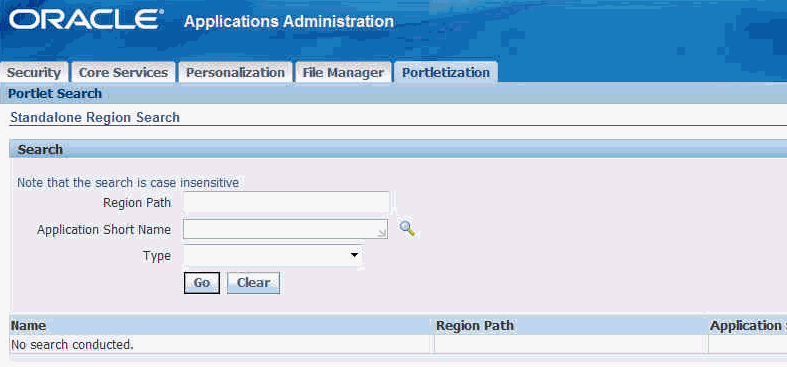
Description of "Figure 54-8 Application Administration Page"
-
Open the Portletization tab and click the Search icon for the Application Short Name field (or enter the Application Short Name if you know it).
Figure 54-9 Application Short Name Search Dialog
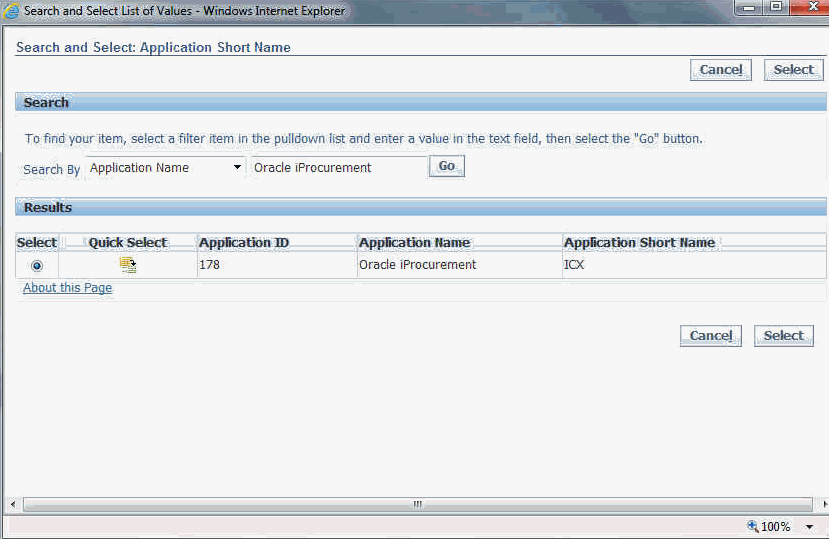
Description of "Figure 54-9 Application Short Name Search Dialog"
-
Select the Search By criteria (for example, select
Application Nameand enterOracle iProcurement) and search for the functionality to portletize. -
Select the row returned in the search results and click Select.
-
Click Go to list the EBS functionality that can be portletized.
-
Click the Portletize icon for the functionality you want to expose (for example,
AdvisoryWarningRN).The Create Portlet dialog displays (see Figure 54-10).
-
Enter the Responsibility to associate the region with (for example,
Preferences SSWA) or use the Search function. -
Click Apply.
-
Continue by registering the EBS producer and integrating it in a portal (see Section 54.3.3.2, "Integrating EBS Applications in a Framework Application") or Framework application (see Section 54.3.3.3, "Integrating EBS Applications in a Portal").
54.3.3.2 Integrating EBS Applications in a Framework Application
This section describes how to integrate an EBS portlet in a Framework application.
This section includes the following subsections:
-
Section 54.3.3.2.1, "Preparing the EBS Portlet for Remote Access"
-
Section 54.3.3.2.2, "Registering the EBS WSRP Producer in the Framework Application"
-
Section 54.3.3.2.3, "Creating a JSF Page to Consume the Remote Producer"
54.3.3.2.1 Preparing the EBS Portlet for Remote Access
Prepare the standalone regions to be portletized as described in the section on Section 54.3.3.1, "Preparing the EBS Portlet for Remote Access."
Before adding the portlets in your Framework application, be sure to bounce the Apache listener as the menu and function definitions are cached.
54.3.3.2.2 Registering the EBS WSRP Producer in the Framework Application
Follow the instructions below to create or open an existing Portal Framework application, and register the EBS WSRP producer.
-
Create a new Portal Framework application or open an existing one in which you would like to consume the remote (WSRP) EBS portlet.
-
Under Application Resources, right-click Connection and select WSRP Producer.
Page 1 (Specify Producer Name) of the Register WSRP Portlet Producer wizard displays.
-
Enter a name for the WSRP producer and click Next.
The Specify Connection Details page displays.
-
Enter the WSDL for the EBS producer in the WSDL URL field as shown below:
WSDL URL: http://[Release_12_host]:[port]/OA_HTML/portlets/WSRPBaseService?WSDL
For example:
http://myEBSServer.example.com:8001/OA_HTML/portlets/WSRPBaseService?WSDL
-
Click Next and then Finish.
The WSRP producer should now appear under Connections.
-
Continue by creating a JSF page to consume the WSRP producer as described in Section 54.3.3.2.3, "Creating a JSF Page to Consume the Remote Producer."
54.3.3.2.3 Creating a JSF Page to Consume the Remote Producer
Use the following procedure to add or use an existing JSF page to consume the EBS remote producer in your Portal Framework application.
To create a JSF page:
-
In the application's Navigation panel, right-click on the application name and select New.
The New Gallery dialog displays.
-
In the Categories field's tree structure, locate and expand the Web Tier.
A list with the descriptions of the available options display in the Items field.
-
From this list, select JSF Page and click OK.
The Create JSF Page dialog displays.
-
Create the JSF page, making sure that the
Create an XML Document (*.jspx)field is selected. For more information about setting up the JSF page, click the Help button to access the online help. -
Click OK.
The newly created JSF page displays.
-
Under connections, expand the newly created WSRP producer and drag the portlet for the EBS page onto the JSF page.
-
In the Portlet Property Inspector, set the RenderPortletInIFrame property to
True. -
Add any other components that you need onto the page, and save the application.
-
Continue by running the page and testing that modifications made in the Portal Framework application appear in the EBS application as described in Section 54.3.3.2.4, "Testing the Framework Application."
54.3.3.2.4 Testing the Framework Application
Use this procedure to test the Portal Framework application by modifying content on the JSF page in the Portal Framework application and checking that the modification shows up in the EBS application.
-
Run the
.jspxpage that you created. -
In the running page, modify some information that you can verify the changes for in the EBS application.
-
Save your changes and confirm that the changes also appear in the EBS application.
54.3.3.3 Integrating EBS Applications in a Portal
This section contains the following subsections:
-
Section 54.3.3.3.1, "Preparing the EBS Portlet for Remote Access"
-
Section 54.3.3.3.2, "Registering the EBS WSRP Producer in WebCenter Portal"
-
Section 54.3.3.3.3, "Adding the EBS Portlet to a Portal Page"
54.3.3.3.1 Preparing the EBS Portlet for Remote Access
Prepare the standalone regions to be portletized as described in the section on Section 54.3.3.1, "Preparing the EBS Portlet for Remote Access."
Before adding the portlets in WebCenter Portal, be sure to bounce the Apache listener as the menu and function definitions are cached.
54.3.3.3.2 Registering the EBS WSRP Producer in WebCenter Portal
You can register the EBS WSRP producer directly in WebCenter Portal, as described in the "Registering Portlet Producers with the Administration Console" section in Oracle Fusion Middleware Administering Oracle WebCenter Portal. You can also register the EBS WSRP producer using Fusion Middleware Control as described in the steps below.
To register the EBS WSRP producer using Fusion Middleware Control:
-
Prepare the EBS page that you want to consume in WebCenter Portal for remote access as described in Section 54.3.3.3.1, "Preparing the EBS Portlet for Remote Access."
-
Log into Fusion Middleware Control for the WebCenter Portal domain (
wc_domainby default). -
Expand
WebCenter Portalin the Navigation bar and from the WebCenter Portal menu, and select Register Producer.The Add Portlet Producer page displays.
-
Enter a Connection Name, set the Producer Type to
WSRP Producer, and paste the WSDL endpoint URL that you copied in step 1 into the URL End Point field. -
Click OK and verify that the producer connection was created successfully.
-
Continue by adding the portlet to a portal page as described in Section 54.3.3.3.3, "Adding the EBS Portlet to a Portal Page."
54.3.3.3.3 Adding the EBS Portlet to a Portal Page
Use the following procedure to consume the EBS remote producer in a portal page.
-
Log into WebCenter Portal.
-
Go to the page, or create a new page, where you want to add the EBS portal.
-
Click Add Content to open Composer.
-
From the Resource Catalog, select Portlets.
Note that if you've created a custom catalog, Portlets may not appear, in which case you will need to add it to the Resource Catalog. For information about managing Resource Catalogs, see the "Working with Resource Catalogs" chapter in Oracle Fusion Middleware Building Portals with Oracle WebCenter Portal.
-
Click the portlet you added in Fusion Middleware Control.
-
Click Add for the EBS portlet you want to add to your portal page.
-
Click Close to close Composer.
-
On the portal page, click the Edit (pencil) icon.
-
Open the Display Options tab and set the Render Portlet in IFrame option to
Trueand click OK. -
Continue by checking the portlet connection as described in Section 54.3.3.3.4, "Testing the Portal Portlet Connection."
54.3.3.3.4 Testing the Portal Portlet Connection
Use this procedure to test the portal portlet connection by modifying content and checking that the modification shows up in the EBS application.
-
On the portal page to which you added the EBS portlet, modify some information that you can verify the changes for in the EBS application.
-
Save your changes and confirm that the changes also appear in the EBS application.
54.3.4 Integrating EBS Applications as Data Controls in WebCenter Portal
This section describes how to add EBS applications as Web service data controls on portal pages.
This section contains the following subsections:
54.3.4.1 Generating the WSDL
This section describes how to create the WSDL.
-
Log on to E-Business Suite as the SYSADMIN user.
-
In the Navigation pane, expand the Integrated SOA Gateway node and under the Integrated SOA Gateway sub-node click Integration Repository.
-
From the Integration Repository tab, navigate to the part of the EBS application to expose. For example, for the price request interface, you would go to Order Management Suite > Advanced Pricing > Price List, and then selecting Price Request from the list of integration points.
-
Click Generate WSDL to expose the integration point (for our example, a PL/SQL API integration point) as a Web service .
-
Right-click the View WSDL link and open the link in a new tab or new window (be sure to keep the tab or window open as you'll need it later).
-
On the Integration Repository page under Procedures and Functions (see Figure 54-11), check the box for the object to grant access to, and then click Grant Access.
Figure 54-11 Integration Repository - Price Request Example
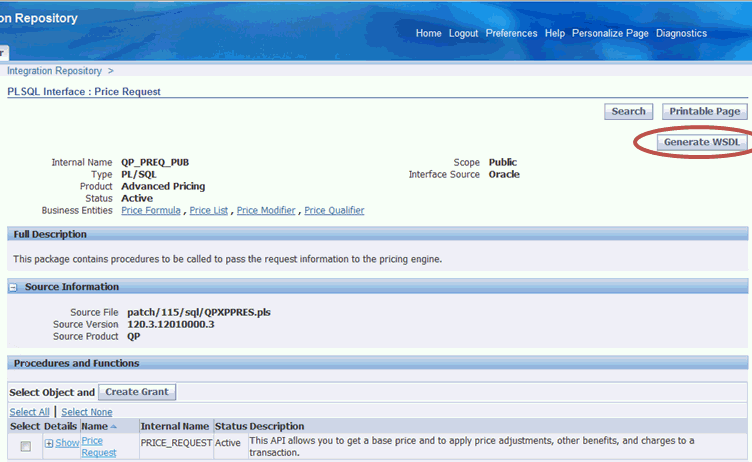
Description of "Figure 54-11 Integration Repository - Price Request Example"
-
Select the Grantee Type and Grantee Name (the user you want to grant access to the exposed object), or use the Search tool. For our example, we will grant access to ASADMIN.
Figure 54-12 Integration Repository - Create Grants Page
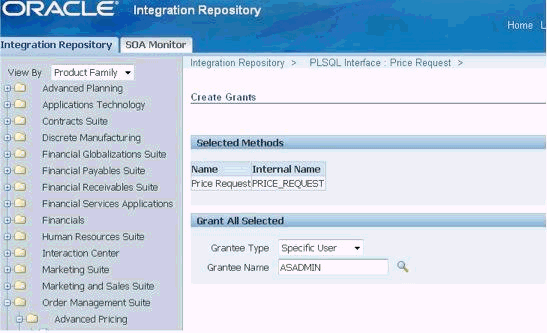
Description of "Figure 54-12 Integration Repository - Create Grants Page"
54.3.4.2 Adding a Web Service Data Control to a Portal Page
Once you have the WSDL, you can continue by using it to create a Web service data control.
Note:
Before you can add a data control or task flow containing a data control to a portal page you must first have configured WS-Security for WebCenter Portal. For more information about configuring WS-Security, see the "Configuring WS-Security" chapter in Oracle Fusion Middleware Administering Oracle WebCenter Portal.For more information about creating a Web service data control, see the "Creating a Web Service Data Control" section in Oracle Fusion Middleware Building Portals with Oracle WebCenter Portal. For information about Web service data controls, see also the "Web Service Data Controls" section in Oracle Fusion Middleware Building Portals with Oracle WebCenter Portal.
To create a Web service data control:
-
In WebCenter Portal or the portal in which you want to create the data control, go to either the Shared Assets or Assets page.
-
Select Data Controls and click Create.
The Create New Data Control dialog displays (see Figure 54-33).
Figure 54-13 Create New Data Control Dialog

Description of "Figure 54-13 Create New Data Control Dialog"
-
In the Create New Data Control dialog, enter a Name and Description for the data control, select
Web Serviceas the Data Control Type, and then click Continue. -
Enter the WSDL URL that you generated in Section 54.3.4.1, "Generating the WSDL" and other details for the data control and click Continue.
-
Click Show Methods.
-
Select the method(s) to make available and click Next.
-
Enter the parameter default values, if any, and click Create.
-
To make the data control available, from the Shared Assets or Assets page, select Task Flows. The Create New Task Flow dialog displays (see Figure 54-35).
-
Enter the task flow Name and Description, select the Mashup Style to use click Create to create the task flow.
-
Select the task flow and click the Edit icon.
-
Add the data control (with param form) as a table onto the task flow and verify the data.
-
To make the task flow available, navigate to Administration > Business Role Pages.
-
Select Business Role Page and click the Create icon.
-
Edit the page and save the changes.
-
Drop the task flow onto the page and verify the data.
54.4 Integrating JD Edwards Applications
This section describes how to integrate JD Edwards applications into WebCenter Portal or a Framework application.
This section contains the following subsections:
-
Section 54.4.1, "Integrating JD Edwards Applications in a Framework Application"
-
Section 54.4.2, "Integrating JD Edwards Applications in a Portal"
54.4.1 Integrating JD Edwards Applications in a Framework Application
This section includes the following subsections:
-
Section 54.4.1.1, "Preparing the JD Edwards Application for Remote Access"
-
Section 54.4.1.2, "Registering the JD Edwards WSRP Producer in the Framework Application"
-
Section 54.4.1.3, "Creating the JSF Page to Consume the Remote Producer"
54.4.1.1 Preparing the JD Edwards Application for Remote Access
Before you can add JD Edwards standalone regions to Portal Framework applications, you must first prepare them to be portletized within JD Edwards by making them available externally as portlets and locating the pre-configured WSDL in the webclient.war/wsdl directory. The WSDL URL is needed so that you can register the JD Edwards WSRP producer and consume it from a Portal Framework application page. To view the XML content of the JDE WSDL in the browser, open the Page source of the page in the browser.
54.4.1.2 Registering the JD Edwards WSRP Producer in the Framework Application
Follow the instructions below to create or open an existing Portal Framework application, and register the JD Edwards WSRP producer.
-
Create a new Portal Framework application or open an existing one in which you would like to consume the remote (WSRP) JD Edwards portlet.
-
Under Application Resources, right-click Connection and select WSRP Producer.
Page 1 (Specify Producer Name) of the Register WSRP Portlet Producer wizard displays.
-
Enter
JDEas the name for the WSRP producer and click Next.The Specify Connection Details page displays.
-
Paste the WSDL URL for the JD Edwards producer into the WSDL URL field.
-
Click Next and then Finish.
The WSRP producer should now appear under Connections.
-
Continue by creating a JSF page to consume the WSRP producer as described in Section 54.4.1.3, "Creating the JSF Page to Consume the Remote Producer."
54.4.1.3 Creating the JSF Page to Consume the Remote Producer
Use the following procedure to add or use an existing JSF page to consume the JD Edwards remote producer in your Portal Framework application.
To create a JSF page:
-
In the application's Navigation panel, right-click on the application name and select New.
The New Gallery dialog displays.
-
In the Categories field's tree structure, locate and expand the Web Tier.
A list with the descriptions of the available options display in the Items field.
-
From this list, select JSF Page and click OK.
The Create JSF Page dialog displays.
-
Create the JSF page, making sure that the
Create an XML Document (*.jspx)field is selected. For more information about setting up the JSF page, click the Help button to access the online help. -
Click OK.
The newly created JSF page displays.
-
Under connections, expand the newly created WSRP producer and drag the portlet for the JD Edwards page onto the JSF page.
-
In the Portlet Property Inspector, set the RenderPortletInIFrame property to
True. -
Add any other components that you need onto the page, and save the application.
-
Continue by running the page and testing that modifications made in the Portal Framework application appear in the JD Edwards application as described in Section 54.4.1.4, "Testing the Framework Application."
54.4.1.4 Testing the Framework Application
Use this procedure to test the Portal Framework application by modifying content on the JSF page in the Portal Framework application and checking that the modification shows up in the JD Edwards application.
-
Run the
.jspxpage that you created. -
In the running page, modify some information that you can verify the changes for in the JD Edwards application.
-
Save your changes and confirm that the changes also appear in the JD Edwards application.
54.4.2 Integrating JD Edwards Applications in a Portal
This section contains the following subsections:
54.4.2.1 Registering the Producer
You can register the JD Edwards WSRP producer directly in WebCenter Portal, as described in the "Registering Portlet Producers with the Administration Console" section in Oracle Fusion Middleware Administering Oracle WebCenter Portal. You can also register the JD Edwards WSRP producer using Fusion Middleware Control as described in the steps below.
To register the JD Edwards WSRP producer using Fusion Middleware Control:
-
Prepare the JD Edwards page that you want to consume in WebCenter Portal for remote access as described in Section 54.4.1.1, "Preparing the JD Edwards Application for Remote Access."
-
Log into Fusion Middleware Control for the WebCenter Portal domain (
wc_domainby default). -
Expand
WebCenter Portalin the Navigation bar and from the WebCenter Portal menu, and select Register Producer.The Add Portlet Producer page displays.
-
Enter
JDEas the Connection Name, set the Producer Type toWSRP Producer, and paste the WSDL endpoint URL that you copied in step 1 into the URL End Point field. -
Click OK and verify that the producer connection was created successfully.
-
Continue by adding the portlet to a portal page as described in Section 54.4.2.2, "Adding the JD Edwards Portlet to a Portal Page."
54.4.2.2 Adding the JD Edwards Portlet to a Portal Page
Use the following procedure to consume the JD Edwards remote producer in WebCenter Portal.
-
Log into WebCenter Portal.
-
Go to the page, or create a new page, where you want to add the JD Edwards portal.
-
Click Add Content to open Composer.
-
From the Resource Catalog, select UI Components and then Portlets.
Note that if you've created a custom catalog, Portlets may not appear, in which case you will need to add it to the Resource Catalog. For information about managing Resource Catalogs, see the "Working with Resource Catalogs" chapter in Oracle Fusion Middleware Building Portals with Oracle WebCenter Portal.
-
Click the portlet you added in Fusion Middleware Control.
-
Click Add for the JD Edwards portlet you want to add to your portal page.
-
Click Close to close Composer.
-
On the portal page, click the Edit (pencil) icon.
-
Open the Display Options tab and set the Render Portlet in IFrame option to
Trueand click OK. -
Continue by checking the portlet connection as described in Section 54.4.2.3, "Testing the Portal Portlet Connection."
54.4.2.3 Testing the Portal Portlet Connection
Use this procedure to test the portal portlet connection by modifying content and checking that the modification shows up in the JD Edwards application.
-
On the portal page that you added the JD Edwards portlet to, modify some information that you can verify the changes for in the JD Edwards application.
-
Save your changes and confirm that the changes also appear in the JD Edwards application.
54.5 Integrating PeopleSoft Applications
This section describes how to integrate PeopleSoft applications in WebCenter Portal or Framework application.
This section contains the following subsections:
-
Section 54.5.1, "Introduction to Integrating PeopleSoft Applications"
-
Section 54.5.2, "Integrating PeopleSoft Applications as WSRP Portlets"
-
Section 54.5.3, "Integrating PeopleSoft Applications as Data Controls in WebCenter Portal"
54.5.1 Introduction to Integrating PeopleSoft Applications
This section describes the benefits and methods involved in integrating PeopleSoft applications into WebCenter Portal and Framework applications.
This section includes the following subsections:
54.5.1.1 Understanding PeopleSoft Integration
PeopleTools 8.51 and later lets you expose PeopleSoft applications as WSRP portlets in remote applications such as WebCenter Portal or a Framework application. This allows people who only need access to a small portion of PeopleSoft's functionality to access it through WebCenter Portal or a Framework application without needing to open or learn the entire PeopleSoft application.
54.5.1.2 Requirements for Integrating PeopleSoft Applications
This section the prerequisites for integrating PeopleSoft objects in WebCenter Portal or a Portal Framework application.
-
PeopleSoft 9.0 or later.
-
PeopleTools 8.51 or later.
-
When using WS-Security for automatic sign on to PeopleSoft, in order for the SAML assertion to be valid, the date/time on the PeopleSoft and Oracle WebCenter Portal servers must be synchronized. If this is problematic, then the PeopleSoft web server's time may be set to be slightly ahead of the Oracle WebCenter Portal server.
-
For PeopleTools 8.51, you may need to create and configure a custom OWSM policy in order to fully support WS-Security. For more information, see Section 54.5.2.6, "Configuring WS-Security for PeopleTools 8.51."
-
For PeopleTools 8.51, only upper case subject names are supported, requiring that only fully upper case user IDs can be used in WebCenter for the integration to work.
54.5.2 Integrating PeopleSoft Applications as WSRP Portlets
This section describes how to expose PeopleSoft applications as WSRP portlets in a portal or Framework application.
This section includes the following subsections:
-
Section 54.5.2.1, "Preparing the PeopleSoft Application for Remote Access"
-
Section 54.5.2.2, "Configuring WS-Security for PeopleTools 8.52 and Later"
-
Section 54.5.2.3, "Attaching a WS-Security Policy to WebCenter Portal"
-
Section 54.5.2.4, "Integrating PeopleSoft Applications in a Portal"
-
Section 54.5.2.5, "Integrating PeopleSoft Applications in a Framework Application"
-
Section 54.5.2.6, "Configuring WS-Security for PeopleTools 8.51"
54.5.2.1 Preparing the PeopleSoft Application for Remote Access
This section describes how to prepare the PeopleSoft application so that it can be consumed by WebCenter Portal or a Framework application.
To prepare the PeopleSoft application:
-
Log into PeopleSoft as an administrator.
-
Select PeopleTools from the main menu.
-
From the People Tools main menu, expand Portal.
-
Select Structure and Content.
The Structure and Content page displays a list of folders containing PeopleSoft objects that could be exposed as a WSRP Portlet (see Figure 54-15).
-
Navigate to the folder and subfolder (if required) containing the service that you want to expose as portlet in WebCenter Portal or Framework application and click Edit to open it. For example, you could select Self Service, Personal Information, and then Personal Information Summary.
The Content Ref Administration page displays (see Figure 54-16).
Figure 54-16 Content Ref Administration Page
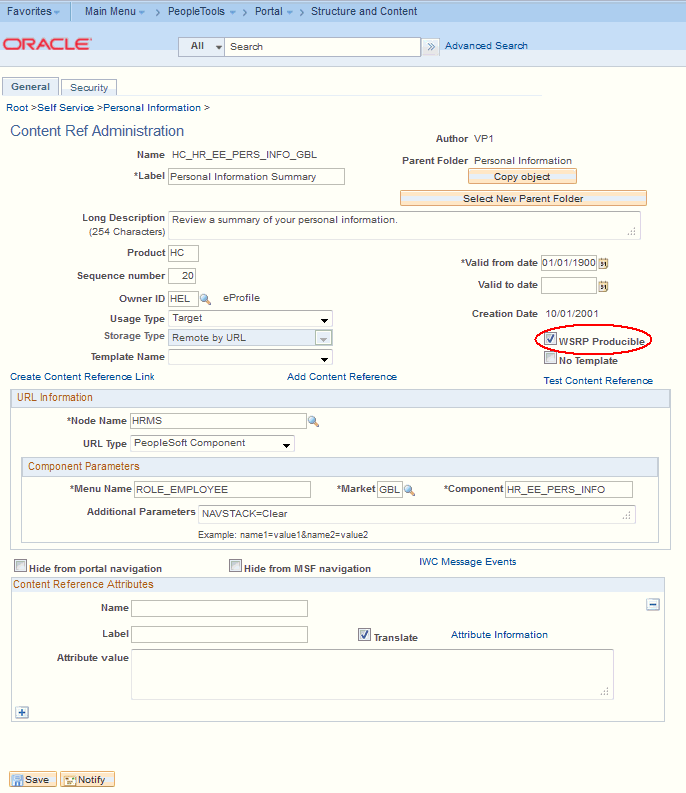
Description of "Figure 54-16 Content Ref Administration Page"
-
On the General tab, select the WSRP Producible checkbox.
-
Save the page.
-
From the main menu, expand PeopleTools and then Portal and select WSRP Production.
The Producer Offered Portlets page displays (see Figure 54-17).
Figure 54-17 Producer Offered Portals Page
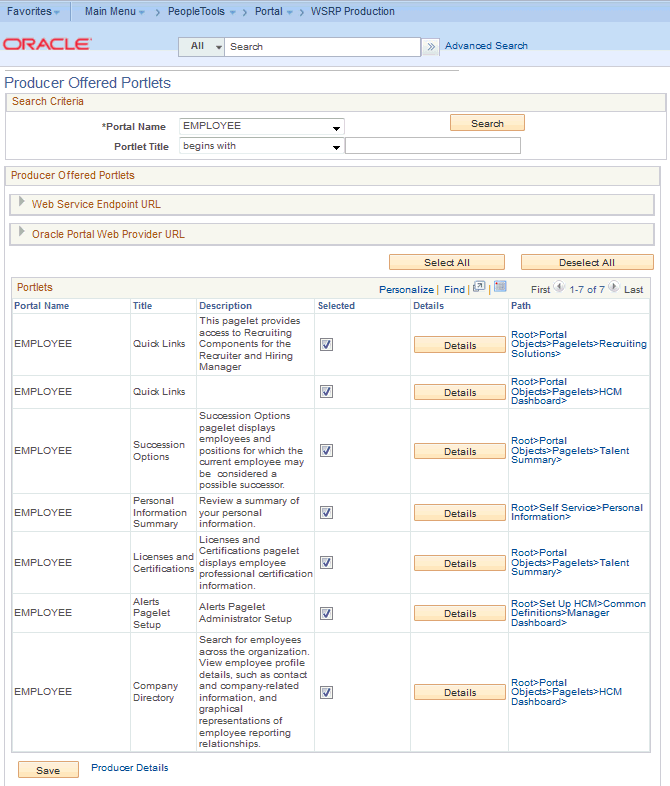
Description of "Figure 54-17 Producer Offered Portals Page"
-
Verify that the service is exposed, and then expand Web Service Endpoint URL and copy the URL (the WSDL).
-
Open a new tab in your browser, and paste the copied URL into the Navigation Bar to access the WSDL page.
-
Copy the URL to the clipboard.
-
Continue by integrating the PeopleSoft WSRP producer in WebCenter Portal or a Framework application as described in Section 54.5.2.5, "Integrating PeopleSoft Applications in a Framework Application" and Section 54.5.2.4, "Integrating PeopleSoft Applications in a Portal."
54.5.2.2 Configuring WS-Security for PeopleTools 8.52 and Later
This section describes how to create a keystore for both Oracle WebCenter Portal and PeopleSoft, and exchange the private key between them. This step is required prior to adding WS-Security policies for both portals and FrameWork applications.
-
First, we will create WebCenter keystore as
webcenter.jkswithorakeyas the private key, and PeopleSoft's public keyrootCAand the certificate that PeopleSoft will use as the WS-Security recipient using the followingkeytoolcommands:./keytool -genkeypair -keyalg RSA -dname "cn=orakey,dc=us,dc=oracle,dc=com" -alias orakey -keypass password -keystore webcenter.jks -storepass password -validity 720 ./keytool -exportcert -v -alias orakey -keystore webcenter.jks -storepass password -rfc -file orakey.cer ./keytool -importcert -trustcacerts -alias orakey -file orakey.cer -keystore peoplesoft.jks -storepass password
-
Next, we will create PeopleSoft keystore as
peoplesoft.jkswithrootCAas the private key and WebCenter's public keyorakeyand the certificate that WebCenter will use as the WS-Security recipient../keytool -genkeypair -keyalg RSA -dname "cn=rootCA,dc=us,dc=oracle,dc=com" -alias rootCA -keypass password -keystore peoplesoft.jks -storepass password -validity 720 ./keytool -exportcert -v -alias rootCA -keystore peoplesoft.jks -storepass password -rfc -file rootca.cer ./keytool -importcert -trustcacerts -alias rootCA -file rootca.cer -keystore webcenter.jks -storepass password
-
After creating the key stores for Oracle WebCenter Portal and PeopleSoft, copy the
peoplesoft.jksto the PeopleSoft host andwebcenter.jksto WebCenter host:-
Copy
peoplesoft.jksto<Domain_Home>/config/fmwconfig/ -
Copy
webcenter.jksto/home/psadm2/psft/pt/8.52/webserv/<Domain_Name>/applications/peoplesoft/pspc.war/WEB-INF/classes
-
-
Install the certificate in PeopleSoft as shown below:
-
Log into PeopleSoft as an administrator and navigate to PeopleTools > Security > Security Objects > Digital Certificate.
The Digital Certificates page displays (see Figure 54-18).
-
Click + to add a new entry.
We need to add digital certificates for
RemoteandRootCAas shown in Figure 54-19. -
Enter the Type as
RootCA, Alias asorakey, Issuer Alias asorakey, and then click the Search icon (magnifying glass). -
Click Import and in the popup, enter the entire text of
orakey.cercreated earlier and click OK. -
Click + to add another new entry, and enter the Type as
Remote, Alias asorakey, Issuer Alias asorakeyand then click the Search icon. -
Click Import and in the popup, enter the entire text of
orakey.cercreated earlier and click OK.
-
-
Update the
WSS.propertiesfile under/home/psadm2/psft/pt/8.52/webserv/<Domain_Name>/applications/peoplesoft/pspc.war/WEB-INF/classesto reference thepeoplesoft.jksfile. -
Use
PSCipher.shto create an Encrypted Password and update the KeyStore password as shown in Figure 54-20. -
Check the local node definition in PeopleSoft:
-
Navigate to Peopletools > Portals > Node Definitions.
The Nodes page displays.
-
Click Search and click PSFT-HR.
-
Select
Passwordfrom the Authentication Option drop-down list and click Save.
-
-
Continue by adding a WS-Security policy to WebCenter Portal or the Framework application as described in Section 54.5.2.3, "Attaching a WS-Security Policy to WebCenter Portal."
54.5.2.3 Attaching a WS-Security Policy to WebCenter Portal
This section describes how to attach a WS-Security policy to WebCenter Portal.
Note:
Before continuing with the steps below you must have configured the WebCenter and PeopleSoft key stores as described in Section 54.5.2.2, "Configuring WS-Security for PeopleTools 8.52 and Later."-
Section 54.5.2.3.1, "Configuring WSS 1.0 SAML Token with Message Integrity"
-
Section 54.5.2.3.2, "Configuring WSS 1.0 Username Token Without Password"
-
Section 54.5.2.3.3, "Configuring WSS 1.0 SAML Token with Message Protection"
-
Section 54.5.2.3.4, "Configuring WSS 1.0 Username Token with Password"
54.5.2.3.1 Configuring WSS 1.0 SAML Token with Message Integrity
Follow the steps below to configure the WSS1.0 SAML Token with Message Integrity policy for WebCenter Portal:
-
Navigate to the following directory on the PeopleSoft server:
/home/psadm2/psft/pt/8.53/webserv/peoplesoft/piabinand run the following command:
./redeployWSRP.sh 6This will update the PeopleSoft WSRP security options to use WSRPBaseService with SAMLToken Full Security.
-
In PeopleSoft, navigate to PeopleTools > Security > SAML Administration Setup > SAML Inbound Setup.
The SAML Inbound Setup page displays (see Figure 54-22).
-
Open the Add a New Value tab and map the WebCenter user with the PeopleSoft user if they use a different OID (example settings are shown below), and then click Save.
Example:
-
Certificate Alias - orakey
-
Issuer - WWW.ORACLE.COM
-
SubjectName - pat
-
QualifierName - WWW.ORACLE.COM
-
Mapping PeopleSoft UserID - PS
-
-
Continue by registering the WSRP producer and adding the portlet to a portal page as shown in Section 54.5.2.4, "Integrating PeopleSoft Applications in a Portal."
54.5.2.3.2 Configuring WSS 1.0 Username Token Without Password
Follow the steps below to attach a WSS 1.0 Username Token without Password policy to WebCenter Portal.
-
Create a WebCenter user in PeopleSoft:
-
In PeopleSoft, navigate to PeopleTools > Security > User Profiles > Copy User Profiles.
The Copy User Profiles page displays (see Figure 54-23).
Figure 54-23 Copy User Profiles Page - Search Criteria
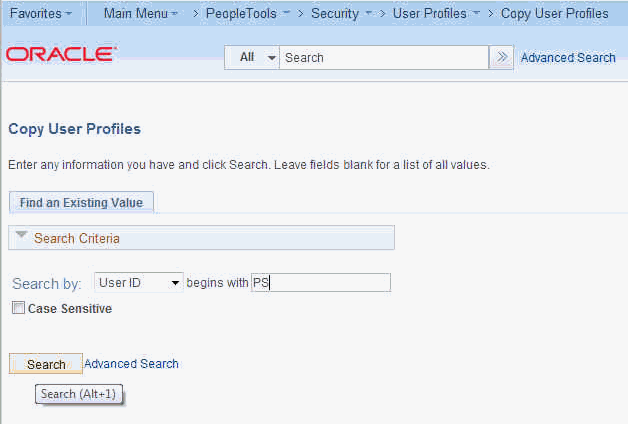
Description of "Figure 54-23 Copy User Profiles Page - Search Criteria"
-
Search for the user to add (
PS, for example).The search results display (see Figure 54-24).
Figure 54-24 Copy User Profiles Page - Search Results
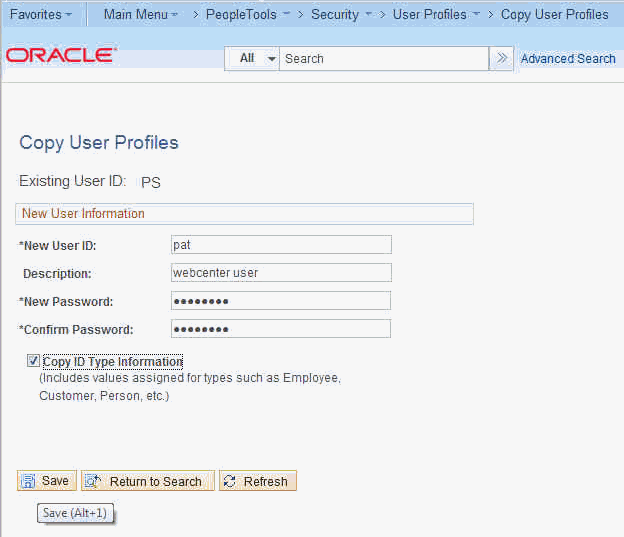
Description of "Figure 54-24 Copy User Profiles Page - Search Results"
-
Enter the New User ID (for example,
Pat), a Description, the New Password, check the Copy ID Type Information option and click Save.
-
-
Log into Fusion Middleware Control, select the domain and navigate to Security > Security Provider Configuration.
The Security Provider Configuration page displays.
-
Open the Keystore section and click Configure.
The Keystore Configuration page displays.
-
Enter
./webcenter.jksfor the KeyStore Path,orakeyfor the Key Alias,orakeyfor the Crypt Alias. Enter the associated passwords and click OK.Note that you must restart the entire domain for the configuration changes to take effect.
-
Navigate to
/home/psadm2/psft/pt/8.53/webserv/peoplesoft/piabinand run the following command:./redeployWSRP.sh 8This will update the PeopleSoft WSRP security options to use WSRPBaseService with UsernameToken, No Password Full Security Option With WSS Response.
-
Continue by registering the WSRP producer and adding the portlet to a portal page as shown in Section 54.5.2.4, "Integrating PeopleSoft Applications in a Portal."
54.5.2.3.3 Configuring WSS 1.0 SAML Token with Message Protection
Follow the steps below to attach the WSS1.0 SAML Token with Message Protection policy to WebCenter Portal.
-
Navigate to
/home/psadm2/psft/pt/8.53/webserv/peoplesoft/piabinand run the following command:./redeployWSRP.sh 10This will update the PeopleSoft WSRP security options to use WSRPBaseService with SAMLToken Full Security Option With WSS Response.
-
Continue by registering the WSRP producer and adding the portlet to a portal page as shown in Section 54.5.2.4, "Integrating PeopleSoft Applications in a Portal."
54.5.2.3.4 Configuring WSS 1.0 Username Token with Password
Follow the steps below to attach the WSS1.0 SAML Token with Message Protection policy to WebCenter Portal.
-
Navigate to
/home/psadm2/psft/pt/8.53/webserv/peoplesoft/piabinand run the following command:./redeployWSRP.sh 7This will update the PeopleSoft WSRP security options to use WSRPBaseService with UsernameToken Full Security Option With WSS Response.
-
Continue by registering the WSRP producer and adding the portlet to a portal page as shown in Section 54.5.2.4, "Integrating PeopleSoft Applications in a Portal."
54.5.2.4 Integrating PeopleSoft Applications in a Portal
This section describes how to integrate a PeopleSoft application in a portal.
This section contains the following subsections:
-
Section 54.5.2.4.1, "Registering the PeopleSoft WSRP Producer for a Portal"
-
Section 54.5.2.4.2, "Adding the PeopleSoft Portlet to a Portal Page"
54.5.2.4.1 Registering the PeopleSoft WSRP Producer for a Portal
You can register the PeopleSoft WSRP producer directly in WebCenter Portal, as described in the "Registering Portlet Producers with the Administration Console" section in Oracle Fusion Middleware Administering Oracle WebCenter Portal. You can also register the PeopleSoft WSRP producer using Fusion Middleware Control as described in the steps below.
To register the PeopleSoft WSRP producer using Fusion Middleware Control:
-
Prepare the PeopleSoft page that you want to consume in WebCenter Portal for remote access as described in Section 54.5.2.1, "Preparing the PeopleSoft Application for Remote Access."
-
Log into Fusion Middleware Control for the WebCenter Portal domain (
wc_domainby default). -
Expand
WebCenter Portalin the Navigation bar and from the WebCenter Portal menu, select Register Producer.The Add Portlet Producer page displays.
-
Set the Producer Type to
WSRP Producer, enter a Connection Name, and paste the WSDL endpoint URL that you copied in step 1 into the URL End Point field. -
If required, configure WS-Security in WebCenter Portal as described in Section 54.5.2.6, "Configuring WS-Security for PeopleTools 8.51."
-
Click OK and verify that the producer connection was created successfully.
-
Continue by adding the portlet to a portal page as described in Section 54.5.2.4.2, "Adding the PeopleSoft Portlet to a Portal Page."
54.5.2.4.2 Adding the PeopleSoft Portlet to a Portal Page
Follow the steps below to add the PeopleSoft portlet to a portal page.
-
Log into WebCenter Portal.
If you configured WS-Security, be sure to use the user account that was used in the SAML Inbound Setup page in PeopleSoft (see Section 54.5.2.3, "Attaching a WS-Security Policy to WebCenter Portal").
-
Go to the page, or create a new page, where you want to add the PeopleSoft portal.
-
Click Add Content to open Composer.
-
From the Resource Catalog, select Portlets.
Note that if you've created a custom catalog, Portlets may not appear, in which case you will need to add it to the Resource Catalog. For information about managing Resource Catalogs, see the "Working with Resource Catalogs" chapter in Oracle Fusion Middleware Building Portals with Oracle WebCenter Portal.
-
Click the portlet you added in Fusion Middleware Control.
-
Click Add for the PeopleSoft page you want to add to your portal page.
-
Click Close to close Composer.
-
On the portal page, click the Edit (pencil) icon.
-
Open the Display Options tab and set the Render Portlet in IFrame option to
Trueand click OK. -
Continue by checking the portlet connection as described in Section 54.5.2.4.3, "Testing the Portal Portlet Connection."
54.5.2.4.3 Testing the Portal Portlet Connection
Use this procedure to test the portal portlet connection by modifying content and checking that the modification shows up in the PeopleSoft application.
-
On the portal page that you added the PeopleSoft portlet to, modify some information that you can verify the changes for in the PeopleSoft application.
-
Save your changes and confirm that the changes also appear in the PeopleSoft application.
54.5.2.5 Integrating PeopleSoft Applications in a Framework Application
This section describes how to create or modify a Portal Framework application that integrates with PeopleSoft Applications.
This section includes the following subsections:
-
Section 54.5.2.5.1, "Registering the PeopleSoft WSRP Producer in the Framework Application"
-
Section 54.5.2.5.2, "Creating the JSF Page to Consume the Remote (WSRP) Producer"
54.5.2.5.1 Registering the PeopleSoft WSRP Producer in the Framework Application
Follow the instructions below to create or open an existing Portal Framework application, and register the PeopleSoft WSRP producer.
-
Use JDeveloper to create a new Framework application (using the WebCenter Portal Framework Application template) or open an existing one in which you would like to consume the remote (WSRP) PeopleSoft portlet.
-
Under Application Resources, right-click Connection and select WSRP Producer.
Page 1 (Specify Producer Name) of the Register WSRP Portlet Producer wizard displays (see Figure 54-25).
-
Enter a name for the WSRP producer and click Next.
The Specify Connection Details page displays (see Figure 54-26).
-
Paste the WSDL (the URL you copied earlier) into the WSDL URL field and click Next.
The Configure Security Attributes page displays.
-
If you are configuring WS-Security, continue with the steps below. Otherwise, continue with step 6.
Note that to configure WS-Security, you must have set up the key stores and attached the policies as described in Section 54.5.2.2, "Configuring WS-Security for PeopleTools 8.52 and Later."
-
From the Token Profile dropdown list, select the WS-Security policy to use.
-
Set the Configuration option to
Custom, the Default User toweblogic, and the Issuer Name towww.oracle.comand click Next.The Specify Keystore page displays.
-
Enter the settings for the keystore based on the configuration settings you defined in Section 54.5.2.2, "Configuring WS-Security for PeopleTools 8.52 and Later."
-
-
Click Finish.
The WSRP producer should now appear under Connections.
-
Continue by creating a JSF page to consume the WSRP producer as described in Section 54.5.2.5.2, "Creating the JSF Page to Consume the Remote (WSRP) Producer."
Note:
Compression must be turned off in WLS to expose WSRP Portlets. Compression is enabled by default in the Producer Web Server running with Weblogic 10.3.2 and must be disabled in the Server Manager setting for compression available for each instance.54.5.2.5.2 Creating the JSF Page to Consume the Remote (WSRP) Producer
Use the following procedure to add a JSF page to consume the PeopleSoft remote producer.
To create a JSF page:
-
In the application's Navigation panel, right-click on the application name and select New.
The New Gallery dialog displays.
-
In the Categories field's tree structure, locate and expand the Web Tier.
A list with the descriptions of the available options display in the Items field.
-
From this list, select JSF Page and click OK.
The Create JSF Page dialog displays.
-
Create the JSF page, making sure that the
Create an XML Document (*.jspx)field is selected. For more information about setting up the JSF page, click the Help button to access the online help. -
Click OK.
The newly created JSF page displays.
-
In the Navigation panel, under Connections, expand the newly created WSRP producer and drag the portlet you created for the PeopleSoft page onto the JSF page.
-
In the Portlet Property Inspector, set the RenderPortletInIFrame property to
True. -
Add any other components that you need onto the page, and save the application.
-
Continue by running the page and testing that modifications made in the Portal Framework application appear in the PeopleSoft application as described in Section 54.5.2.5.3, "Testing the Framework Application."
54.5.2.5.3 Testing the Framework Application
Use this procedure to test the Portal Framework application by modifying content on the JSF page in the Portal Framework application and checking that the modification shows up in the PeopleSoft application.
-
Run the
.jspxpage that you created. -
In the running page, modify some information that you can verify the changes for in the PeopleSoft application.
-
Save your changes and confirm that the changes also appear in the PeopleSoft application.
54.5.2.6 Configuring WS-Security for PeopleTools 8.51
This section describes the supported OWSM policies for PeopleTools 8.51. It is important to note that PeopleTools release 8.51 does not support outgoing WS-Security headers in its messages. However, some out-of-the-box Oracle WebCenter Portal/OWSM policies require that both outgoing and incoming messages be secured. To bridge this gap you may need to create custom OWSM policies. The different integration scenarios that would require you to create custom WS-Security policies, and the steps required on the Oracle WebCenter Portal side to configure them are also described in this section.
For integration scenarios with PeopleTools 8.51, you can use WSS10 SAML Token with Message Integrity, WSS10 SAML Token with Message Protection, or WSS10 Username Token with Password as OWSM the policy.
This section includes the following subsections:
-
Section 54.5.2.6.1, "Configuring WS-Security for WSS10 SAML Token with Message Integrity"
-
Section 54.5.2.6.2, "Configuring WS-Security for WSS10 SAML Token with Message Protection"
-
Section 54.5.2.6.3, "Configuring WS-Security for WSS10 Username Token with Password"
54.5.2.6.1 Configuring WS-Security for WSS10 SAML Token with Message Integrity
(PeopleSoft policy: WSRPBaseService with SAMLToken Full Security Option (timestamp) )
This section describes how to configure WS-Security for the WSS10 SAML Token with Message Integrity (oracle/wss10_saml_token_with_message_integrity_client_policy) policy.
To configure WS-Security:
-
Configure the Oracle WebCenter Portal/OWSM keystore as shown in the chapter "Configuring WS-Security" in the Oracle Fusion Middleware Administering Oracle WebCenter Portal.
-
Generate a certificate containing the public key of the Oracle WebCenter Portal domain and send it to the PeopleTools administrator so it can be imported in the PeopleTools configuration.
-
When you register the producer, choose
wss10_saml_token_with_message_integrity_client_policy. -
Continue by adding the WSRP portlet to WebCenter Portal or a Framework application page.
54.5.2.6.2 Configuring WS-Security for WSS10 SAML Token with Message Protection
(PeopleSoft policy: WSRPBaseService with SAMLToken Full Security Option (timestamp) With WSS Response)
The default WSS10 SAML Token with Message Protection (oracle/wss10_saml_token_with_message_protection_client_policy) policy that ships with OWSM requires that response also be signed and encrypted. However, PeopleTools release 8.51 and earlier cannot send WS-Security headers in response (only the initial cookie/get portlet handle call contains security headers; subsequent calls do not) and we therefore need to create and attach a custom policy based on the oracle/wss10_saml_token_with_message_protection_client_policy policy.
To create a custom policy:
-
Log into Fusion Middleware Control and navigate to the Oracle WebCenter Portal domain (
wc_domainby default). -
From the WebLogic Domain menu, select Web Services > Policies.
-
Select the
wss10_saml_token_with_message_protection_client_policyand click Create Like. -
Give the policy a new name (for example,
oracle/wss10_saml_token_with_message_protection_plaintext_response_client_policy). -
Open the Response tab, uncheck the Include Entire Body check boxes under Message Signing Setting and Message Encrypt Setting, and save the policy.
-
Check that the public certificate of the PeopleSoft keystore is imported into the keystore used in the Oracle WebCenter Portal domain.
-
Use WLST to register the producer using the newly created policy as shown in the following example:
registerWSRPProducer('webcenter', 'wc-pt851-saml_msg-protection', 'http://xmlns.oracle.com/pspc/pswsdl/ps/EMPLOYEE', timeout=100, tokenType='oracle/wss10_saml_token_with_message_protection_plaintext_response_client_policy', enforcePolicyURI='false', issuer='www.oracle.com', sigKeyAlias='webcenter',sigKeyPswd='welcome1', encKeyAlias='webcenter', encKeyPswd='welcome1', recptAlias='peopleTools_public')Use the alias for the imported
peoplesftpublic key as the value for therecptAliasparameter.Note:
You must use WLST to register the producer. Fusion Middleware Control can only accept fixed policy names and therefore you must register the producer with this policy using WLST by passing inenforcePolicyURI='false'.
54.5.2.6.3 Configuring WS-Security for WSS10 Username Token with Password
(PeopleSoft policy: WSRPBaseService with UsernameToken Full Security Option With WSS Response)
The default WSS10 Username Token with Password (oracle/wss10_username_token_with_message_protection_client_policy) policy that ships with OWSM requires that response also be signed and encrypted. However, PeopleTools release 8.51 and earlier cannot send WS-Security headers in response (only the initial cookie/get portlet handle call contains security headers; subsequent calls do not) and we therefore need to create and attach a custom policy based on the oracle/wss10_username_token_with_message_protection_client_policy policy.
To create a custom policy:
-
Log into Fusion Middleware Control and navigate to the Oracle WebCenter Portal domain (
wc_domainby default). -
From the WebLogic Domain menu, select Web Services > Policies.
-
Select the
wss10_username_token_with_message_protection_client_policyand click Create Like. -
Give the policy a new name (for example,
oracle/wss10_username_token_with_message_protection_plaintext_response_client_policy). -
Open the Response tab, uncheck the Include Entire Body check boxes under Message Signing Setting and Message Encrypt Setting, and save the policy.
-
Check that the public certificate of the PeopleSoft keystore is imported into the keystore used in the Oracle WebCenter Portal domain.
-
Use WLST to register the producer using the newly created policy as shown in the following example:
registerWSRPProducer('webcenter', '<Producer_Name>', '<URL>', timeout=100, tokenType='oracle/wss10_username_token_with_message_protection_plaintext_response_client_policy', extApp='<Ext_App_Name>', enforcePolicyURI='false', issuer='www.oracle.com', sigKeyAlias='webcenter',sigKeyPswd='welcome1', encKeyAlias='webcenter', encKeyPswd='welcome1', recptAlias='peopleTools_public')Use the alias for the imported
peoplesftpublic key as the value for therecptAliasparameter.Note:
You must use WLST to register the producer. Fusion Middleware Control can only accept fixed policy names and therefore you must register the producer with this policy using WLST by passing inenforcePolicyURI='false'.
54.5.3 Integrating PeopleSoft Applications as Data Controls in WebCenter Portal
This section describes how to add PeopleSoft applications as Web service data controls on portal pages.
This section includes the following subsections:
54.5.3.1 Preparing the WSDL
Follow the steps below to prepare a the WSDL.
-
Log into the PeopleSoft Console as an administrator.
-
Navigate to PeopleTools > Web Profile > Web Profile Configuration.
-
Click Search and select
DEVfrom the results list.Figure 54-27 WebProfile Configuration Page
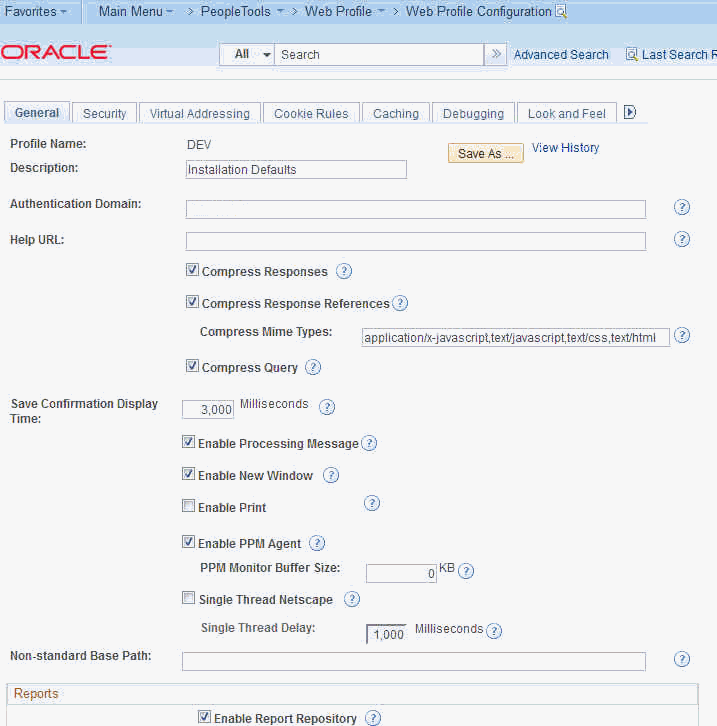
Description of "Figure 54-27 WebProfile Configuration Page"
-
Open the General tab and enter the Authentication Domain for your host.
For example, if your host name is
ps.example.com, enter.example.comin the Authentication Domain field. -
Save your changes and close the application.
-
Open the
C:\Windows\System32\drivers\etc\hostsfile for editing. -
On a new line enter the IP address and the full host name with the authentication domain.
For example:
193.128.1.113 ps.example.com -
Save the file and reboot the server.
-
Log into the PeopleSoft application using the following URL:
http://<host_name>:8000/ps/signon.htmlFor example:
http://ps.example.com:8000/ps/signon.html -
From the Main Menu, navigate to PeopleTools > Integration Broker > Configuration > Gateways.
-
Search for the GatewayID
LOCAL. The Local Gateway URL is set tohttp://<host_name>:8000/PSIGW/PeopleSoftListeningConnector -
Using the Local Gateway URL, ping the gateway to make sure it's active.
-
Open the Gateway Setup Properties and log in as an administrator.
-
On the PeopleSoft Node Configuration page, check that the node being used is
PSFT_HR. -
Ping the node
-
From the Main Menu, navigate to PeopleTools > Integration Broker > Configuration > Service Configuration.
-
Open Setup Target Locations and check that the Target Location is set to
<Local Gateway URL>/PSFT_HR. -
From the Main Menu, navigate to PeopleTools > Integration Broker > Integration Setup > Nodes.
-
Click Search.
-
Click the Default Local Node
PSFT_HR. -
On the Nodes tab, check that the Default UserID is set correctly as in the example in Figure 54-28.
Figure 54-28 Nodes Page - Node Definitions

Description of "Figure 54-28 Nodes Page - Node Definitions"
-
Click Return to Search.
-
Click the ANONYMOUS node.
-
Change the default UserID to the PeopleSoft Login ID (for example, PS) as in the example in Figure 54-29.
Figure 54-29 Nodes Page - Nodes Definitions

Description of "Figure 54-29 Nodes Page - Nodes Definitions"
-
Save the changes and navigate to Main Menu > PeopleTools > Integration Broker > Web Services > CI-Based Services.
-
Search for and select the Component Interface Name (for example,
CURRENCY) as in the example in Figure 54-30.Figure 54-30 CI-Based Services Page - Select Component Interfaces
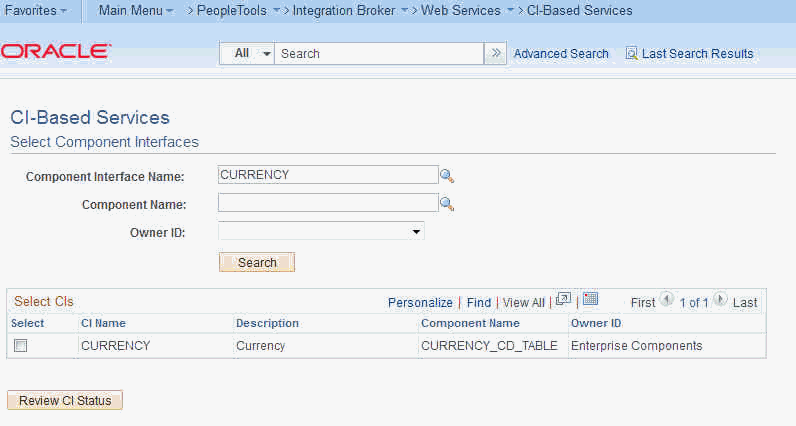
Description of "Figure 54-30 CI-Based Services Page - Select Component Interfaces"
-
Click Review CI Status.
The CI-Based Services - Review Status page displays (see Figure 54-31).
Figure 54-31 Review CI-Based Status - Review Status Page
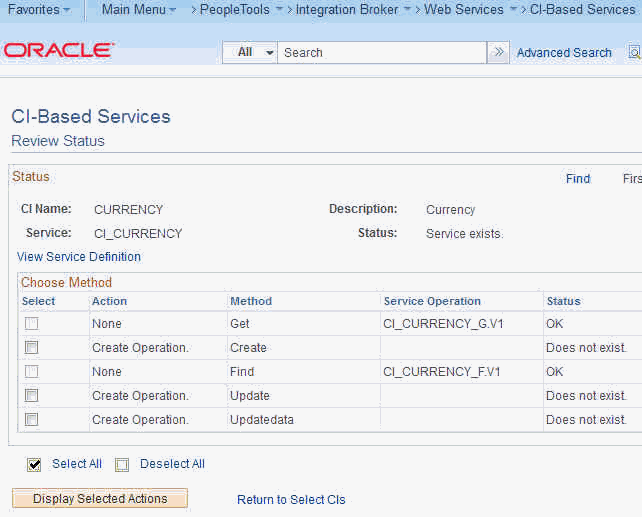
Description of "Figure 54-31 Review CI-Based Status - Review Status Page"
-
Select the available methods (
GetandFind, in this case) and click Display Selected Actions. -
On the Confirm Actions dialog, click Perform Selected actions.
-
Click View Service Definition.
-
Click Provide Web Service.
The Select Service Operations page displays (see Figure 54-32).
Figure 54-32 Select Service Operations Page

Description of "Figure 54-32 Select Service Operations Page"
-
Select the Select All check box and click Next until you reach the last page.
-
Click Finish to generate the WSDL.
You should now be able to access the WSDL URL. For this example, the URL would be:
http://ps.example.com:8000/PSIGW/PeopleSoftServiceListeningConnector/PSFT_HR/CI_CURRENCY.1.wsdl\\\\ -
Continue by creating w Web service data control as shown in Section 54.5.3.2, "Creating a Web Service Data Control."
54.5.3.2 Creating a Web Service Data Control
Once you have the WSDL, you can continue by using it to create a Web service data control. In this section we'll continue with the example we started in Section 54.5.3.1, "Preparing the WSDL."
Note:
Before you can add a data control or task flow containing a data control to a portal page you must first have configured WS-Security for WebCenter Portal. For more information about configuring WS-Security, see the "Configuring WS-Security" chapter in Oracle Fusion Middleware Administering Oracle WebCenter Portal.For more information about creating a Web service data control, see the "Creating a Web Service Data Control" section in Oracle Fusion Middleware Building Portals with Oracle WebCenter Portal. For information about Web service data controls, see also the "Web Service Data Controls" section in Oracle Fusion Middleware Building Portals with Oracle WebCenter Portal.
To create a Web service data control:
-
In WebCenter Portal or the portal in which you want to create the data control, go to either the Shared Assets or Assets page.
-
Select Data Controls and click Create.
The Create New Data Control dialog displays (see Figure 54-33).
Figure 54-33 Create New Data Control Dialog

Description of "Figure 54-33 Create New Data Control Dialog"
-
In the Create New Data Control dialog, enter a Name and Description for the data control, select
Web Serviceas the Data Control Type, and then click Continue. -
Enter the WSDL URL and other details for the data control and click Continue. For our example, the URL would be:
http://ps.example.com:8000/PSIGW/PeopleSoftServiceListeningConnector/PSFT_HR/CI_CURRENCY.1.wsdl -
For our example, enter the Default Value for
CURRENCY_CDasUSDand click Create (see Figure 54-34).Figure 54-34 Create New Data Control Dialog - CI_Currency_G Method Parameters

Description of "Figure 54-34 Create New Data Control Dialog - CI_Currency_G Method Parameters"
-
To make the data control available, from the Shared Assets or Assets page, select Task Flows. The Create New Task Flow dialog displays (see Figure 54-35).
-
Click Create to create the task flow.
-
Select the task flow and click the Edit icon.
-
Add the data control (with param form) as a table onto the task flow and verify the data.
-
To make the task flow available, navigate to Administration > Business Role Pages.
-
Select Business Role Page and click the Create icon.
-
Edit the page. and save the changes.
-
Drop the task flow onto the page and verify the data.
54.6 Integrating Oracle Business Intelligence Presentation Services
This section explains how to use JDeveloper to create and configure a Portal Framework application that integrates with the Oracle Business Intelligence Presentation Services catalog. At runtime, users can add business intelligence objects to their portal or Framework application pages.
This section includes the following subsections:
-
Section 54.6.1, "Introduction to Integrating Oracle Business Intelligence Presentation Services"
-
Section 54.6.2, "Configuring Credentials for Connecting to the Oracle BI Presentation Catalog"
-
Section 54.6.4, "Integrating Oracle Business Intelligence Objects in WebCenter Portal"
54.6.1 Introduction to Integrating Oracle Business Intelligence Presentation Services
This section explains how you use JDeveloper to create a Portal Framework application, or configure WebCenter Portal to integrate with the Oracle Business Intelligence Presentation Services catalog. For more information about adding Oracle Business Intelligence objects to Portal Framework applications, see "Embedding Business Intelligence Objects in ADF Applications" in the Oracle Fusion Middleware Developer's Guide for Oracle Business Intelligence Enterprise Edition.
This section includes the following subsections:
-
Section 54.6.1.1, "Understanding Oracle Business Intelligence Presentation Services Integration"
-
Section 54.6.1.2, "Requirements for Integrating Oracle Business Intelligence Presentation Services"
54.6.1.1 Understanding Oracle Business Intelligence Presentation Services Integration
You can use JDeveloper to create Portal Framework applications that integrate with Oracle Business Intelligence Presentation Services. At runtime, these applications include the Presentation Services catalog in the WebCenter Portal - Resource catalog. Users can then browse for and add business intelligence analyses, dashboard pages, dashboards, or scorecard components (strategy maps, strategy trees, KPI watchlists, cause and effect maps, and custom views) to their Portal Framework application pages. Any filters, prompts, and actions links included in the Business Intelligence objects will work within the Portal Framework application or portal pages.
At runtime, Oracle WebCenter Portal users can expand and browse the Presentation Services catalog's folders to view an analysis' views. The following view types display in the Presentation Services catalog: table, pivot table, chart, funnel chart, gauge, narrative, ticker and title. The following view types do not display in the Presentation Services catalog: view selector, column selector, logical SQL, and no-results view.
Users can also browse the dashboard folder for the pages associated with the dashboard; however, users cannot browse within the dashboard pages to see their components (for example, any analyses embedded in the dashboard). Users cannot include entire Scorecards (only a Scorecard's components) in their Portal Framework application pages.
54.6.1.2 Requirements for Integrating Oracle Business Intelligence Presentation Services
To create a Portal Framework application that integrates with Oracle Business Intelligence Presentation Services, you must have installed Oracle JDeveloper 11g Release 1 (11.1.1.6) or later and the required Oracle BI EE and WebCenter Portal extensions.
To properly create the Portal Framework application, you must configure the library settings, update the weblogic.xml and weblogic-application.xml files, and have properly configured security.
For both Portal Framework applications and portals, you must also set up a connection to the BI application as well as configuring security as described in the "Creating an Oracle BI EE Presentation Services Connection" section in Oracle Fusion Middleware Developer's Guide for Oracle Business Intelligence Enterprise Edition. You will also need to specify the credentials for the connection, as described in Section 54.6.2, "Configuring Credentials for Connecting to the Oracle BI Presentation Catalog."
The following prerequisites apply:
Oracle WebCenter Portal
-
The
WC_Spacesserver has been installed and configured, including the database connection, Content Server connection, and Fusion Middleware Control
OBIEE
-
Oracle Business Intelligence Applications
-
OBI Enterprise Edition version 11.1.1.7.0
-
OBI Applications version 7.9.6.3 (Optional)
-
OBIEE is already installed, configured, and up and running (Database – OBI Enterprise Edition)
-
OBI Applications is installed and set up and all content is available from the OBIEE environment (Optional)
Security
The OBIEE integration requires that the identity store user name population be the same across WebCenter and OBIEE. This can be done by either:
-
Having WebCenter and OBIEE share the same identity store (recommended)
-
Maintaining identical user names across separate WC and OBIEE identity stores
54.6.1.3 Advanced Integration Options
The sections below focus on adding resources such as business intelligence analyses, dashboards, and scorecard components that can be easily dropped onto a page. As well as these approaches, there are also options for using Web services and BI EE Logical SQL view object to embed business intelligence data into a Framework application. For more information about using Web services, see the "Introduction to Oracle Business Intelligence Web Services" section in Oracle Fusion Middleware Integrator's Guide for Oracle Business Intelligence Enterprise Edition. For more information about using the BI EE Logical SQL view object, see the "Using the Oracle BI EE Logical SQL View Object" section in Oracle Fusion Middleware Developer's Guide for Oracle Business Intelligence Enterprise Edition.
54.6.2 Configuring Credentials for Connecting to the Oracle BI Presentation Catalog
At design time, you need to specify credentials to connect to the Oracle BI Presentation Catalog. These credentials are used to retrieve the list of business intelligence objects (for example, analyses, dashboards, and scorecard components) from the Oracle BI Presentation Catalog.
This process ensures that the login to the Presentation Server is the same as the current user of the application and any access checks are performed as the current user, and data is fetched as the current user. If the ADF page contains business intelligence objects to which the user does not have access, the ADF page returns a message stating that the user does not have the proper permissions to access these objects.
Note that the Perform impersonation parameter should be set to true when security is enabled.
This section contains the following subsections:
54.6.2.1 Checking for the BIImpersonatorUser
Use the following steps to check if a BIImpersonatorUser user already exists, and that the roles assigned to it are correct:
-
Open WLS Administration Console for your Oracle BI EE instance using an Administrator account.
-
Locate the Domain Structure pane and select Security Realm.
The Realms pane displays.
-
In the Realms pane, select <myrealm>.
The Settings dialog displays.
-
In the Settings dialog, open the Users and Groups tab.
-
Check that BIImpersonatorUser appears in the list of users.
If the BIImpersonatorUser does not appear in the list, continue by creating the BIImpersonatorUser as shown in Section 54.6.2.2, "Creating the BIImpersonatorUser."
-
Log into Fusion Middleware Control with an administrator account.
-
In the Navigation panel, expand the
Weblogic Domainnode and selectbifoundation_domain. -
From the Weblogic Domain menu, select Security > Application Policies.
-
On the Application Policies page under Search, choose obi from the Application Stripe dropdown list.
-
From the Principal Type drop down list, select
User. -
In the Name field, enter
BIImpersonatorUserand start the search (Figure 54-36).Figure 54-36 Application Policies Pane - bifoundation_domain
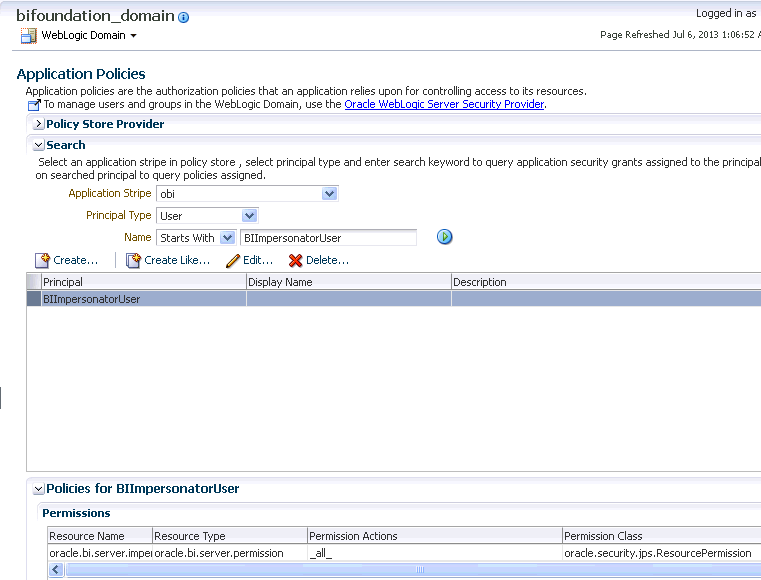
Description of "Figure 54-36 Application Policies Pane - bifoundation_domain"
-
If found, check that:
-
Resource Name =
oracle.bi.server.impersonatorUser -
Resource Type =
oracle.bi.server.permission -
Permission Actions = _all_
-
Permission Class =
oracle.security.jps.ResourcePermission
-
-
If the BIImpersonatorUser is not found, continue by adding permissions for the BIImpersonatorUser as shown in Section 54.6.2.3, "Granting Permissions to BIImpersonatorUser."
54.6.2.2 Creating the BIImpersonatorUser
Use the following procedures to create a BIImpersonatorUser user to secure an application that uses an Oracle BI EE Presentation Services connection and includes Oracle BI EE objects. ADF security must be enabled for your application before you can apply the impersonator user credentials to the Oracle BI EE Presentation Services connection.
The Impersonate User feature secures applications that contain Oracle BI EE objects when Oracle BI EE and ADF are not sharing an Oracle Internet Directory (OID). Before you begin the process of creating and using Impersonate User, you must confirm that this capability is configured in your environment.
Before you perform this procedure, make sure that either you or the Administrator have created users in the WebLogic Server's Oracle BI EE realm and assigned the BIConsumer group to each user in this realm. For more information, see "How to Create and Use Impersonate User" in the Oracle Fusion Middleware Developer's Guide for Oracle Business Intelligence Enterprise Edition.
Follow the steps below to create the BIImpersonatorUser user:
-
Open WLS Administration Console for your Oracle BI EE instance using an Administrator account.
-
Locate the Domain Structure pane and select Security Realm.
The Realms pane displays.
-
In the Realms pane, select <myrealm>.
The Settings dialog displays.
-
In the Settings dialog, open the Users and Groups tab.
-
Confirm that the Users tab is displaying and click New.
-
Enter
BIImpersonatorUserfor the user name and enter a password. -
Click OK.
54.6.2.3 Granting Permissions to BIImpersonatorUser
Follow the steps below to use Fusion Middleware Control to grant permissions to BIImpersonatorUser:
-
Open Fusion Middleware Control for your Oracle BI EE instance.
-
In the Navigation panel, expand the
Weblogic Domainnode and selectbifoundation_domain.The
bifoundation_domainpane displays. -
In the
bifoundation_domainpane, open the WebLogic Domain menu and select Security > Application Policies.The Search pane displays.
-
On the Application Policies page under Search, choose obi from the Application Stripe dropdown list.
-
Click Create.
The Create Application Grant pane displays (Figure 54-37).
Figure 54-37 Create Application Grant Pane
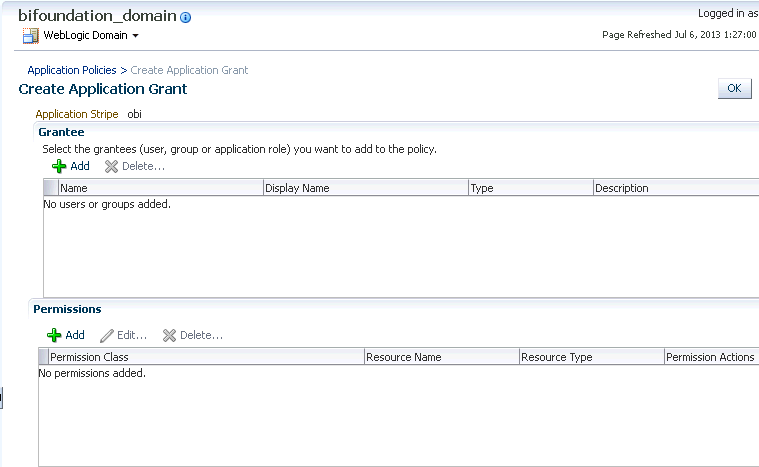
Description of "Figure 54-37 Create Application Grant Pane"
-
Under Grantees, click Add.
The Add User dialog displays.
-
From the Type drop down list, select
User. -
In the Principal Name field, enter
oracle.bi.server.impersonatorUserand click OK. -
Under Permissions, click Add.
The Add Permission dialog displays (Figure 54-38).
-
Select Permissions and in the Permission Class field, enter
oracle.security.jps.ResourcePermission. -
In the Resource Name field, enter
oracle.bi.server.impersonatorUser, start the search and then click Continue. -
If the search did not return anything, in the Permission Class field enter
oracle.security.jps.ResourcePermission, and in the Resource Name field enteroracle.bi.server.impersonatorUser. -
Click Select.
-
On the Application Grant page, click OK.
-
If the changes that you made do not display, stop and restart the following servers:
-
Oracle BI EE Server
-
Oracle BI EE Presentation Server
-
WebLogic Server
-
54.6.3 Integrating Oracle Business Intelligence Presentation Services in Framework Applications
This section describes how to install the required BI extensions, and create or modify a Portal Framework application that integrates with Oracle Business Intelligence Presentation Services.
This section includes the following subsections:
-
Section 54.6.3.1, "Installing the Required Business Intelligence Extensions"
-
Section 54.6.3.4, "Post-Deployment Connection Configuration"
-
Section 54.6.3.5, "Securing Oracle BI EE Objects Included in a Framework Application"
54.6.3.1 Installing the Required Business Intelligence Extensions
Use this procedure to install the required Business Intelligence extensions:
-
From the JDeveloper Help menu, select Check for Updates.
-
Follow the steps in the wizard to locate, download, and install the Oracle BI EE extensions. Be sure to install the bundles in the following order:
-
bi-soap-cn_bundle -
bi-vo_bundle -
bi-adf_bundle -
bi-adf-taskflow-extension_bundle
-
-
Also use the wizard to download and install the Oracle WebCenter Framework Extension bundle (
oracle.webcenter.framework_bundle.zip).
54.6.3.2 Creating a Framework Application that Integrates with Oracle BI Presentation Services
Use the following procedures to create or modify a Portal Framework application that can access the Oracle Business Intelligence Presentation Services catalog at runtime. Before following these steps you should already have created the BIImpersonatorUser, as described in Section 54.6.2, "Configuring Credentials for Connecting to the Oracle BI Presentation Catalog."
This section includes the following subsections:
-
Section 54.6.3.2.1, "Creating the Framework Application and JSF Page"
-
Section 54.6.3.2.2, "Configuring the Application to Display the Oracle BI EE Presentation Catalog"
-
Section 54.6.3.2.3, "Enabling the BI ADF Task Flow Permission"
54.6.3.2.1 Creating the Framework Application and JSF Page
Use the following procedure to create a Portal Framework application and add a JSF page.
To create a Portal Framework application and JSF page:
-
In Oracle JDeveloper, create a new
WebCenter Portal - Framework application(be sure to check the checkbox for Configure the Application with Standard Portal Features).The user name/password in this case should be
BIImpersonatorUser/<password>, where<password>is the password that you set when you created the user. -
Create a connection to the BI application as described in the section "How to Configure SSL and Create an Oracle BI EE Presentation Services Connection" in the Oracle Fusion Middleware Developer's Guide for Oracle Business Intelligence Enterprise Edition.
When you create the connection, be sure to set Perform impersonation when security is enabled the to
trueand change the username and password to the Impersonate User credentials (BIImpersonatorUser/<password>) as described above. -
In the Navigation panel, right-click on the Portal project and select New.
The New Gallery dialog displays.
-
In the Categories field's tree structure, locate and expand the Web Tier.
A list with the descriptions of the available options display in the Items field.
-
From this list, select JSF Page and click OK.
The Create JSF Page dialog displays.
-
Create the JSF page, making sure that the
Create an XML Document (*.jspx)field is selected. For more information about setting up the JSF page, click the Help button to access the online help. -
Click OK.
The newly created JSPX page displays.
-
In the Component Palette pane, select Composer.
The field updates to display the corresponding components, layouts, and operations.
-
From the Common Components category, select Change Mode Link and drag and drop it onto your page.
-
From the Common Components category, select Page Customizable.
-
Save the application.
-
Right-click the page in Design view and choose Edit Authorization.
-
Navigate to Granted to > Select authenticated-users and under Actions grant authenticated users
Customize,Grant,Personalize, andViewprivileges.
54.6.3.2.2 Configuring the Application to Display the Oracle BI EE Presentation Catalog
Use this procedure to add the Presentation Catalog to the Portal Framework application's folder list. At runtime, the catalog displays in the WebCenter Portal - Resource Catalog where the users can browse to business intelligence objects and add them to their Portal Framework application page.
To display the Presentation Catalog in the Portal Framework application's folder list:
-
In the Portal Framework application that you created with Oracle JDeveloper, from the Application menu, right-click Portal Project and select Project Properties.
The Project Properties dialog displays.
-
In the available properties pane, select Technology Scope and from the Available field, select Business Intelligence ADF View Components, and click the Add (>) icon to add it to the project's technology scope. Note that you can also add the BI technology libraries when you create a new application.
-
In the available properties pane, select Libraries and Classpath, and click Add Library.
The Add Library dialog displays.
-
Add the following libraries to the project, and click OK.
-
BI ADF Runtime
-
BI ADF Taskflow
-
BI SOAP Connection Runtime
-
BI View Object Runtime
-
-
Save the application.
-
In JDeveloper, open the default resource catalog file (
default-catalog.xml) located in Portal > Web Content > Oracle > webcenter > portalapp > catalogs. -
Add the following
<customFolder>entry under the<catalogDefinition> - ><contents>folder:<customFolder id="oracleBIContent" name="Oracle BI" description="Oracle BI Presentation Services Content" factoryClass="oracle.bi.presentation.rescat. BICatalogInitialContextFactory"/> -
Edit
Weblogic.xmland add references tooracle.bi.adf.view.slibandoracle.bi.adf.webcenter.slibas shown below:<library-ref> <library-name>oracle.bi.adf.view.slib</library-name> </library-ref> <library-ref> <library-name>oracle.bi.adf.webcenter.slib</library-name> </library-ref> </weblogic-web-app>
-
Edit
weblogic-application.xmland add a reference tooracle.bi.adf.model.slibas shown below:<library-ref> <library-name>oracle.bi.adf.model.slib</library-name> </library-ref> </weblogic-application>
54.6.3.2.3 Enabling the BI ADF Task Flow Permission
Use the following procedure to enable the BI ADF task flow permissions in your application's security settings.
To enable the BI ADF task flow permissions:
-
Open the
jazn-data.xmlfile from Application Resources Pane > META-INF > jazn-data.xml. -
Locate the following code in the file:
<grantee> <principals> <principal> <class> oracle.security.jps.internal.core.principals.JpsAnonymousRoleImpl </class> <name>anonymous-role</name> </principal> </principals> </grantee> -
Add the following element:
<permission> <class>oracle.adf.controller.security.TaskFlowPermission</class> <name>/WEB-INF/oracle/bi/presentation/taskflow/ task-flow-definition.xml#task-flow-definition</name> <actions>customize,personalize,view</actions> </permission>For example:
<grant> <grantee> <principals> <principal> <class>oracle.security.jps.internal.core.principals .JpsAnonymousRoleImpl</class> <name>anonymous-role</name> </principal> </principals> </grantee> <permissions> <permission> <class>oracle.adf.controller.security.TaskFlowPermission</class> <name>/WEB-INF/oracle/bi/presentation/taskflow/ task-flow-definition.xml#task-flow-definition</name> <actions>customize,personalize,view</actions> </permission>
54.6.3.3 Testing the Framework Application
This section describes how to test the Portal Framework application by performing the following procedures:
-
Adding Oracle BI Presentation Services catalog content and modifying a report or dashboard's prompt values
-
Confirming and modifying a business intelligence object's initialization parameters.
This section includes the following subsections:
-
Section 54.6.3.3.1, "Adding Oracle BI Objects to the Resource Catalog"
-
Section 54.6.3.3.2, "Adding Business Intelligence Content at Runtime"
-
Section 54.6.3.3.3, "Modifying a Business Intelligence Object's Prompt Values"
-
Section 54.6.3.3.4, "Modifying a Business Intelligence Task Flow's Initialization Parameters"
54.6.3.3.1 Adding Oracle BI Objects to the Resource Catalog
Before you can add Oracle BI content to a Portal Framework application page, you must add objects stored in the Oracle BI Presentation Catalog to the WebCenter Portal - Resource Catalog.
-
Run the application in a browser.
-
Log into the Portal Framework application as an administrator.
-
Click Administration.
The WebCenter Portal Administration Console displays.
-
Open the Resources tab.
-
Click Resources Catalogs.
-
Click Create a Resource Catalog.
-
In the Name field, enter the name of the catalog you are creating. Complete the other fields on this dialog, as necessary.
-
Click Edit > Show for the resource catalog.
-
Click the Edit menu and then choose Edit.
-
From the Add menu, choose Add From Library....
-
Double-click Connections.
The BI Presentation Services folder displays in the right frame. Open this folder to display the Oracle BI objects.
-
Browse to and select the objects that you want to add.
-
Click Add to add the selected objects to the catalog.
-
Open the Configuration tab and select the resource catalog you just created as the Default Resource Catalog.
54.6.3.3.2 Adding Business Intelligence Content at Runtime
Use this procedure to test the Portal Framework application by adding business intelligence content to the Portal Framework application.
-
Run the
.jspxpage that you created. -
In the running page, click the Edit link to enter the edit mode.
-
Click Add Content.
The WebCenter Portal - Resource Catalog displays.
-
Browse to and open the Oracle BI folder.
-
Click the BI connection or host machine to which you want to connect.
The contents of the catalog display.
-
Browse to and click the Add link for the object that you want to add to the
.jspxpage. -
Confirm that the application correctly added the object.
54.6.3.3.3 Modifying a Business Intelligence Object's Prompt Values
Use this procedure to test the Portal Framework application by changing an analysis or dashboard's filter or prompt values.
-
Run the
.jspxpage that you created. -
In the running page, click the Edit link to enter the edit mode.
-
Add an analysis or dashboard that contains a filter or prompt.
For more information about adding business intelligence content to the .jspx page, see Section 54.6.3.3.2, "Adding Business Intelligence Content at Runtime."
-
Click Parameters.
The Editing Page dialog displays.
-
Modify the values and click Save.
-
Confirm that the application correctly applied the modified prompt values.
54.6.3.3.4 Modifying a Business Intelligence Task Flow's Initialization Parameters
Use the following procedure to test the business intelligence task flow's initialization parameters.
-
Run the
.jspxpage that you created. -
In the running page, click the Edit link to enter the edit mode.
-
Add a business intelligence object.
For more information about adding business intelligence content to the .jspx page, see Section 54.6.3.3.2, "Adding Business Intelligence Content at Runtime."
-
Locate the business intelligence object and click the Edit (wrench) icon.
The Component Properties dialog displays.
-
Open the Parameters tab, modify the object's parameters, and click OK.
-
Confirm that the application correctly applied the modified prompt values.
54.6.3.4 Post-Deployment Connection Configuration
After an application has been deployed, use Fusion Middleware Control to add a new Oracle BI EE Presentation Services connection to the application, or modify the application's existing Oracle BI EE Presentation Services connection with the user name and password for BIImpersonatorUser.
For more information about modifying these connections, see "Adding or Modifying a Presentation Services Connection After Deployment" in the Oracle Fusion Middleware Developer's Guide for Oracle Business Intelligence Enterprise Edition.
Note:
If the Framework application and the Oracle Business Intelligence application do not share the same identity store, you must create the relevant users in both system.54.6.3.5 Securing Oracle BI EE Objects Included in a Framework Application
Impersonate User lets you secure a Portal Framework application that integrates with Oracle BI EE Presentation Services. For more information about Impersonate User and how to implement it to secure your application, see "How to Create and Use Impersonate User" in the Oracle Fusion Middleware Developer's Guide for Oracle Business Intelligence Enterprise Edition.
54.6.4 Integrating Oracle Business Intelligence Objects in WebCenter Portal
Use the following procedures to configure portal integration with the BI objects.
-
Section 54.6.4.1, "Adding or Modifying a Presentation Services Connection After Deployment"
-
Section 54.6.4.2, "Adding Oracle BI Objects to the WebCenter Portal Resource Catalog"
-
Section 54.6.4.4, "Modifying a Business Intelligence Object's Prompt Values"
-
Section 54.6.4.5, "Modifying a Business Intelligence Task Flow's Initialization Parameters"
54.6.4.1 Adding or Modifying a Presentation Services Connection After Deployment
Before you can begin integrating BI objects in WebCenter Portal, you must first configure a connection from WebCenter Portal to the BI server. Oracle BI EE provides an ADF MBean that lets you add a new connection to a deployed portal or BI ADF application. You can also modify a deployed application's existing connection. MBeans are deployed with the application and can be accessed post-deployment using Fusion Middleware Control.
Prior to following the steps below, you should already have followed the steps in Section 54.6.2, "Configuring Credentials for Connecting to the Oracle BI Presentation Catalog" to specify credentials to connect to the Oracle BI Presentation Catalog.
Note:
If the portal and the Oracle Business Intelligence application do not share the same identity store, you must create the relevant users in both systems.Follow the steps below to configure the connection after the application was deployed.
-
Open Fusion Middleware Control and select your WebLogic domain by doing one of the following:
-
If your application is deployed in the BI ADF domain, select the Application Deployments <your domain> tree node.
-
If your application is deployed in the WebCenter Portal domain, select the WebCenter tree node, and then the WebCenter Portal tree node, and then the webcenter(11.1.1.4.0) (WC_Spaces) tree node. Note that the
WC_Spacesserver must be running in order to perform this step.
-
-
From the list, select System MBean Browser.
The System MBean Browser pane displays.
-
In the System MBean Browser pane, navigate to the ADF Connections tree node by following the below path:
-
Select the Application Defined MBeans tree node.
-
Select the oracle.adf.share.connections tree node.
-
Select the Server: <my server name> tree node.
For example,
Server:DefaultServerorServer:WC_Spaces. -
Select the Application:<your application's name> tree node.
For example,
Application:Application2orApplication:webcenter. -
Open the ADF Connections tree node.
-
Open the child ADF Connections tree node.
The corresponding MBean information displays in the Application Defined MBean pane.
-
-
In the Application Defined MBean pane, open the Operations tab and then click createConnection to create a Presentation Services connection.
The Operation:createConnection dialog displays.
-
Specify the required values for the connection.
In the connection type Value field, enter
BISoapConnection, enter a name in the connection name Value field and click Invoke to create the connection. -
In the System MBean Browser pane, click Refresh to refresh the tree so that the new connection displays.
-
To modify the connection, locate it in the System MBean Browser pane and click it.
The connection's information displays in the Application Defined MBean pane.
-
Navigate to ADF Connections from the System MBean Browser pane and open the Attributes tab.
-
Enter the
BISoapconnection information as shown below, and then click Apply to apply your changes.-
From the OBIEE URL to the login page you need:
context = analytics host = <host name> port = 7001 or the local value protocol = HTTP
-
From BIImpersonatorUser you need:
username = BIImpersonatorUser password = <password>
-
-
Click on the ADFConnections folder in the Navigation pane, open the Operations tab, and then click Save to save the connection.
-
When you click Invoke, you should get the following message:
"
Confirmation Operation executed successfully."
54.6.4.2 Adding Oracle BI Objects to the WebCenter Portal Resource Catalog
Before you can add Oracle BI content to a portal page, you must add objects stored in the Oracle BI Presentation Catalog to the WebCenter Portal Resource Catalog.
-
Log into WebCenter Portal as an administrator.
-
In WebCenter Portal, click Administration.
The Administration page displays.
-
Open the Shared Assets tab and click Resource Catalogs.
-
Click Create.
-
In the Name field, enter the name of the catalog you are creating. Complete the other fields on this dialog, as necessary.
-
Make the Resource Catalog available by checking its Available check box.
-
Select the new resource catalog and click Edit.
-
Select the Add menu and then choose Add From Library.....
-
Double-click Connections.
The BI Presentation Services folder displays.
-
Open this folder to display the Oracle BI objects and browse to and select the objects that you want to add.
-
Click Add to add the selected objects to the catalog.
Continue by adding the object to a Framework application. For more information about managing resource catalogs at runtime, see the "Working with resource catalogs" section in Oracle Fusion Middleware Building Portals with Oracle WebCenter Portal. For information about managing Resource Catalogs in JDeveloper, see Chapter 14, "Developing Resource Catalogs."
54.6.4.3 Adding Oracle BI Content at Runtime
Use this procedure to create a portal page and add Oracle BI objects to it. Before you perform this procedure, you must have added Oracle BI objects to the WebCenter Portal Resource Catalog.
-
Log into WebCenter Portal and create a new portal or access an existing portal.
-
Make the Resource Catalog the default catalog for the portal.
-
From the Pages and Portals dropdown list, select Manage > Settings and under Assets, select the catalog created in Section 54.6.4.2, "Adding Oracle BI Objects to the WebCenter Portal Resource Catalog" as the default resource catalog for Pages.
-
Click Save.
-
-
From the Pages and Portals dropdown list, select Create > Page.
-
Browse to the folder containing the Oracle BI objects.
-
Select an analysis or dashboard and click Add.
The object that you selected is added to the page.
54.6.4.4 Modifying a Business Intelligence Object's Prompt Values
Use this procedure to test the portal page by changing an analysis or dashboard's filter or prompt values.
-
Open the page that you created.
-
In the running page, click Page Actions and then click the Edit link to enter edit mode.
-
Add an analysis or dashboard that contains a filter or prompt. For more information about adding Oracle BI objects to the page, see Section 54.6.4.3, "Adding Oracle BI Content at Runtime."
-
Without exiting the edit mode of the page, save the portal page.
-
In the portal page, modify the prompt values and click OK.
-
Exit edit mode, save the page and confirm that the application correctly applied the prompt values.
54.6.4.5 Modifying a Business Intelligence Task Flow's Initialization Parameters
Use the following procedure to test the business intelligence task flow's initialization parameters.
-
Open the page that you created.
-
In the running page, click Page Actions and then click the Edit link to enter the edit mode.
-
Add an analysis or dashboard that is part of a task flow. For more information about adding business intelligence content to the
.jspxpage, see Section 54.6.4.3, "Adding Oracle BI Content at Runtime." -
Without exiting the edit mode for the page, save the portal page.
-
Locate the business intelligence object and click the Edit (wrench) icon.
The Component Properties dialog displays.
-
On the portal page, open the Parameters tab and modify the object's parameters and click OK.
-
Open the Parameters tab, modify the object's parameters, and click OK.
-
Exit edit mode, save the page and confirm that the application correctly applied the modified parameter values.
